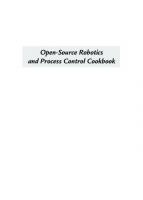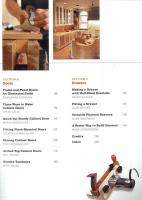Open-Source Robotics and Process Control Cookbook: Designing and Building Robust, Dependable Real-time Systems 0750677783, 9780750677783
ESBUS PC-host interface ·In this practical reference, popular author Lewin Edwards shows how to develop robust, dependa
201 84 1MB
English Pages 256 Year 2004
Local Disk......Page 0
000001.pdf......Page 2
000002.pdf......Page 3
000003.pdf......Page 4
000004.pdf......Page 5
000005.pdf......Page 6
000006.pdf......Page 7
000007.pdf......Page 8
000008.pdf......Page 9
000009.pdf......Page 10
000010.pdf......Page 11
000011.pdf......Page 12
000012.pdf......Page 13
000013.pdf......Page 14
000014.pdf......Page 15
000015.pdf......Page 16
000016.pdf......Page 17
000017.pdf......Page 18
000018.pdf......Page 19
000019.pdf......Page 20
000020.pdf......Page 21
000021.pdf......Page 22
000022.pdf......Page 23
000023.pdf......Page 24
000024.pdf......Page 25
000025.pdf......Page 26
000026.pdf......Page 27
000027.pdf......Page 28
000028.pdf......Page 29
000029.pdf......Page 30
000030.pdf......Page 31
000031.pdf......Page 32
000032.pdf......Page 33
000033.pdf......Page 34
000034.pdf......Page 35
000035.pdf......Page 36
000036.pdf......Page 37
000037.pdf......Page 38
000038.pdf......Page 39
000039.pdf......Page 40
000040.pdf......Page 41
000041.pdf......Page 42
000042.pdf......Page 43
000043.pdf......Page 44
000044.pdf......Page 45
000045.pdf......Page 46
000046.pdf......Page 47
000047.pdf......Page 48
000048.pdf......Page 49
000049.pdf......Page 50
000050.pdf......Page 51
000051.pdf......Page 52
000052.pdf......Page 53
000053.pdf......Page 54
000054.pdf......Page 55
000055.pdf......Page 56
000056.pdf......Page 57
000057.pdf......Page 58
000058.pdf......Page 59
000059.pdf......Page 60
000060.pdf......Page 61
000061.pdf......Page 62
000062.pdf......Page 63
000063.pdf......Page 64
000064.pdf......Page 65
000065.pdf......Page 66
000066.pdf......Page 67
000067.pdf......Page 68
000068.pdf......Page 69
000069.pdf......Page 70
000070.pdf......Page 71
000071.pdf......Page 72
000072.pdf......Page 73
000073.pdf......Page 74
000074.pdf......Page 75
000075.pdf......Page 76
000076.pdf......Page 77
000077.pdf......Page 78
000078.pdf......Page 79
000079.pdf......Page 80
000080.pdf......Page 81
000081.pdf......Page 82
000082.pdf......Page 83
000083.pdf......Page 84
000084.pdf......Page 85
000085.pdf......Page 86
000086.pdf......Page 87
000087.pdf......Page 88
000088.pdf......Page 89
000089.pdf......Page 90
000090.pdf......Page 91
000091.pdf......Page 92
000092.pdf......Page 93
000093.pdf......Page 94
000094.pdf......Page 95
000095.pdf......Page 96
000096.pdf......Page 97
000097.pdf......Page 98
000098.pdf......Page 99
000099.pdf......Page 100
000100.pdf......Page 101
000101.pdf......Page 102
000102.pdf......Page 103
000103.pdf......Page 104
000104.pdf......Page 105
000105.pdf......Page 106
000106.pdf......Page 107
000107.pdf......Page 108
000108.pdf......Page 109
000109.pdf......Page 110
000110.pdf......Page 111
000111.pdf......Page 112
000112.pdf......Page 113
000113.pdf......Page 114
000114.pdf......Page 115
000115.pdf......Page 116
000116.pdf......Page 117
000117.pdf......Page 118
000118.pdf......Page 119
000119.pdf......Page 120
000120.pdf......Page 121
000121.pdf......Page 122
000122.pdf......Page 123
000123.pdf......Page 124
000124.pdf......Page 125
000125.pdf......Page 126
000126.pdf......Page 127
000127.pdf......Page 128
000128.pdf......Page 129
000129.pdf......Page 130
000130.pdf......Page 131
000131.pdf......Page 132
000132.pdf......Page 133
000133.pdf......Page 134
000134.pdf......Page 135
000135.pdf......Page 136
000136.pdf......Page 137
000137.pdf......Page 138
000138.pdf......Page 139
000139.pdf......Page 140
000140.pdf......Page 141
000141.pdf......Page 142
000142.pdf......Page 143
000143.pdf......Page 144
000144.pdf......Page 145
000145.pdf......Page 146
000146.pdf......Page 147
000147.pdf......Page 148
000148.pdf......Page 149
000149.pdf......Page 150
000150.pdf......Page 151
000151.pdf......Page 152
000152.pdf......Page 153
000153.pdf......Page 154
000154.pdf......Page 155
000155.pdf......Page 156
000156.pdf......Page 157
000157.pdf......Page 158
000158.pdf......Page 159
000159.pdf......Page 160
000160.pdf......Page 161
000161.pdf......Page 162
000162.pdf......Page 163
000163.pdf......Page 164
000164.pdf......Page 165
000165.pdf......Page 166
000166.pdf......Page 167
000167.pdf......Page 168
000168.pdf......Page 169
000169.pdf......Page 170
000170.pdf......Page 171
000171.pdf......Page 172
000172.pdf......Page 173
000173.pdf......Page 174
000174.pdf......Page 175
000175.pdf......Page 176
000176.pdf......Page 177
000177.pdf......Page 178
000178.pdf......Page 179
000179.pdf......Page 180
000180.pdf......Page 181
000181.pdf......Page 182
000182.pdf......Page 183
000183.pdf......Page 184
000184.pdf......Page 185
000185.pdf......Page 186
000186.pdf......Page 187
000187.pdf......Page 188
000188.pdf......Page 189
000189.pdf......Page 190
000190.pdf......Page 191
000191.pdf......Page 192
000192.pdf......Page 193
000193.pdf......Page 194
000194.pdf......Page 195
000195.pdf......Page 196
000196.pdf......Page 197
000197.pdf......Page 198
000198.pdf......Page 199
000199.pdf......Page 200
000200.pdf......Page 201
000201.pdf......Page 202
000202.pdf......Page 203
000203.pdf......Page 204
000204.pdf......Page 205
000205.pdf......Page 206
000206.pdf......Page 207
000207.pdf......Page 208
000208.pdf......Page 209
000209.pdf......Page 210
000210.pdf......Page 211
000211.pdf......Page 212
000212.pdf......Page 213
000213.pdf......Page 214
000214.pdf......Page 215
000215.pdf......Page 216
000216.pdf......Page 217
000217.pdf......Page 218
000218.pdf......Page 219
000219.pdf......Page 220
000220.pdf......Page 221
000221.pdf......Page 222
000222.pdf......Page 223
000223.pdf......Page 224
000224.pdf......Page 225
000225.pdf......Page 226
000226.pdf......Page 227
000227.pdf......Page 228
000228.pdf......Page 229
000229.pdf......Page 230
000230.pdf......Page 231
000231.pdf......Page 232
000232.pdf......Page 233
000233.pdf......Page 234
000234.pdf......Page 235
000235.pdf......Page 236
000236.pdf......Page 237
000237.pdf......Page 238
000238.pdf......Page 239
000239.pdf......Page 240
000240.pdf......Page 241
000241.pdf......Page 242
000242.pdf......Page 243
000243.pdf......Page 244
000244.pdf......Page 245
000245.pdf......Page 246
000246.pdf......Page 247
000247.pdf......Page 248
000248.pdf......Page 249
000249.pdf......Page 250
000250.pdf......Page 251
000251.pdf......Page 252
000252.pdf......Page 253
000253.pdf......Page 254
000254.pdf......Page 255
000255.pdf......Page 256
file:///C|/Documents and Settings/me/デスクトップ/desktop/pictures/getpedia.html......Page 1
Recommend Papers

- Author / Uploaded
- Lewin Edwards Lewin Edwards is an embedded engineer with over 15 years experience designing embedded systems hardware firmware and control software.
- Similar Topics
- Technique
- Electronics: Robotics
File loading please wait...
Citation preview
w w w .Ge t Pe dia .com * Th e Ebook st a r t s fr om t h e n e x t pa ge : En j oy !
Open-SourceRobotics andProcessControlCookbook
This page intentionally left blank
Open-SourceRobotics andProcessControlCookbook DesigningandBuildingRobust, DependableReal-TimeSystems byLewinA.R.W.Edwards
AMSTERDAM • BOSTON • HEIDELBERG • LONDON NEW YORK • OXFORD • PARIS • SAN DIEGO SAN FRANCISCO • SINGAPORE • SYDNEY • TOKYO Newnes is an imprint of Elsevier
NewnesisanimprintofElsevier 30CorporateDrive,Suite400,Burlington,MA01803,USA LinacreHouse,JordanHill,OxfordOX28DP,UK Copyright©2005,ElsevierInc.Allrightsreserved. Nopartofthispublicationmaybereproduced,storedinaretrievalsystem,ortransmittedin anyformorbyanymeans,electronic,mechanical,photocopying,recording,orotherwise, withoutthepriorwrittenpermissionofthepublisher. PermissionsmaybesoughtdirectlyfromElsevier’sScience&TechnologyRightsDepartmentinOxford,UK:phone:(+44)1865843830,fax:(+44)1865853333,e-mail: [email protected].Youmayalsocompleteyourrequeston-lineviatheElsevier homepage(http://elsevier.com),byselecting“CustomerSupport”andthen“Obtaining Permissions.” Recognizingtheimportanceofpreservingwhathasbeenwritten,Elsevierprintsits booksonacid-freepaperwheneverpossible. LibraryofCongressCataloging-in-PublicationData
(Applicationsubmitted.)
BritishLibraryCataloguing-in-PublicationData AcataloguerecordforthisbookisavailablefromtheBritishLibrary. ISBN:0-7506-7778-3 ForinformationonallNewnespublications, visitourWebsiteatwww.books.elsevier.com 04050607080910987654321 PrintedintheUnitedStatesofAmerica.
Dedication ThisbookisdedicatedtomywifeCristen,inrecognitionofheruncomplaining acceptanceofyardsofPVCconduitinhallways,poundsofgel-cellsinthelivingroom, andnever-endingsnarlsofwireandmotorsthroughoutthehouse.
v
This page intentionally left blank
Contents
AbouttheAuthor........................................................................... xi What’sontheCD-ROM?...............................................................xii Chapter1:Introduction................................................................... 1 1.1HistoryofthisBookandWhatYou’llGetFromReadingIt.........................1 1.2TargetReadershipandRequiredSkillsandTools.........................................5 1.3ConventionsUsedintheText.......................................................................7
Chapter2:Microcontrollers,Single-BoardComputersand DevelopmentTools.................................................................. 9 2.1TheDivisionofLabor....................................................................................9 2.2CandidateMicrocontrollersfor‘Hard’Tasks...............................................13 2.3TheAtmelAVRanditsDevelopmentHardwareUpClose.......................17 2.4Candidatex86-basedSBCsfor‘Soft’Tasks.................................................21 2.5TheAdvantechPCM-5820Single-BoardComputerUpClose.................27 2.6SelectinganInter-ModuleCommunicationsProtocol...............................32
Chapter3:SomeExampleSensor,Actuatorand ControlApplicationsandCircuits(HardTasks)...................... 41 3.1Introduction.................................................................................................41 3.2E2BUSPC-HostInterface...........................................................................44 3.3Host-to-ModuleCommunicationsProtocol................................................49
vii
Contents 3.4StepperMotorController............................................................................52 3.5Speed-ControlledDCMotorwithTachFeedbackandThermalCutoff.......70 3.6Two-AxisAttitudeSensorusingMEMSAccelerometer............................79 3.7RS-422—CompatibleIndicatorPanel.........................................................90
Chapter4:TheLinux-BasedController(ASoftTask)................... 115 4.1ABriefIntroductiontoEmbeddingLinuxonPCHardware....................115 4.2ConfiguringtheDevelopmentSystemandCreatingOurCustomKernel..117 4.3TheLinuxBootProcess—CreatingaBootableCompactFlashCard.......123 4.4CreatingaRootFilesystemforourEmbeddedSystem..............................128 4.5CreatingaBootableLinuxSystem-RestoreCD-ROMDisc.....................136 4.6UsingtheParallelPortasaGeneral-PurposeI/OInterfaceinLinux.......142 4.7ImplementingGraphicalControlInterfaces.............................................149 4.8Infra-RedRemoteControlinLinuxUsingLIRC.....................................175 4.9IntroductiontoMachineVisionUsingVideo4Linux...............................189 4.10CustomizingYourBIOS—TheStructureofaModernBIOS.................201
Chapter5:EncryptionandDataSecurityPrimer.......................... 209 5.1Introduction...............................................................................................209 5.2ClassesofAlgorithm..................................................................................214 5.3ProtectingOne-WayControlDataStreams..............................................217 5.4ProtectingOne-WayTelemetry.................................................................218 5.5ProtectingBidirectionalControl/DataStreams........................................220 5.6ProtectingLoggedData..............................................................................222 5.7WheretoObtainEncryptionAlgorithms.................................................224
viii
Contents
Chapter6:ExpectingtheUnexpected........................................... 227 6.1Introduction...............................................................................................227 6.2DangerousExceptionConditionsandRecoveringFromThem...............228 6.3On-Chipvs.Off-ChipWatchdogHardware.............................................230 6.4GoodPower-OnResetPractices................................................................232 6.5AFewAdditionalConsiderationsforBattery-PoweredApplications......235
Chapter7:ContentsoftheEnclosedCD-ROM............................ 237 Index........................................................................................... 237
ix
This page intentionally left blank
AbouttheAuthor
LewinA.R.W.EdwardswasborninAdelaide,Australia.Heworkedforfiveyears inMelbourne,Australiaongovernment-approvedencryption,desktopprotection anddatasecurityproductsforDOS,WindowsandOS/2.Forthenextfiveyears,he workedinPortChester,NewYorkforDigi-Frame,Inc.,wherehedesignedboththe hardwareandfirmwareofarangeofmultimediadigitalpictureframeappliances. Thesedevicesrangedincomplexityfromsmallpocket-sizestill-imageviewersup tofullynetworkedwall-mounteddeviceswithaudioandfull-motionvideosupport. HecurrentlylivesinNewYorkCityandworksasashort-rangeradiodigitaldesign engineerforawell-knownmanufacturerofwirelesssecurityandfiresafetyproducts. HisearlierworksincludeEmbeddedSystemsDesignonaShoestring,(abookaboutlowcostembeddedsystemsdevelopment,principallytargetedatARM7platforms),as wellasarticlesonspecializeddesignconsiderationsforthemicrocontrollersusedin electronictoys,commentaryonUniversalPlug’N’Play,reverse-engineeringInternet appliances,andothertopicsofinterest.
xi
What’sontheCD-ROM?
IncludedontheaccompanyingCD-ROM: ■
AfreeversionoftheschematiccaptureandPCBCADsoftwareusedtopreparethisbook.(Refertothelicenseagreementincludedwiththesoftwarefor usagerestrictionsandlimitations.)
■
AtmelAVRStudio®4.08.
■
Fullschematicsandsourcecodefortheprojectsdescribedinthisbook.
■
Ready-madediskimagesfortheminiatureLinuxdistributionusedasabasis forthebook’sPC-sidesoftware.
■
DistributionarchivesofthesourcecodeforallGNUsoftwareused,alongwith application-specificpatches,whereappropriate.
xii
CHAPTER
1
Introduction 1.1HistoryofthisBookandWhatYou’llGetFromReadingIt Overthecourseofroughlyayear,aftercompletingmyfirstbook,Iresurrectedanold petprojectofbuildinganautonomoussubmarine(referredtoastheE-2project)with certainfairlychallengingfunctionalityrequirements.Inthecourseofdevelopingthis idea,IspentmanyhoursontheInternetandelsewhere,researchingtechniquesfor rapiddevelopmentofvariouselectromechanicalcontrolsystemsandplatformstorun fairlycomplexsignal-processingalgorithms.Althoughthereare,ofcourse,thousands ofusefulprojectsandsnippetsofinformationtobeobtainedfromtheInternetand booksonhobbyistrobotics,Ifoundthatnobodyelseseemedtohavemyexactpriorities.Inparticular,thereisapparentlynosinglereferencethatgatherstogetherat leastintroductorysolutionstoalltheembeddeddesignissuesthataffectedmyproject:aneedtouselow-cost(open-source)toolsandoperatingsystems,arequirement forseveralfeatureswithfairlyhardreal-timerequirements,andadesiretousecheap, off-the-shelfconsumergradecomponentswhereverpossible.Availableresourceson manytopicsconcentrateeitheronveryexpensiveoff-the-shelfindustrialcomponents,orontightlyconstrainedsystemsbuiltaroundasinglemicrocontroller,with delicatelyoptimized,nonportablecodetocontrolperipherals—andaverylimited rangeofperipheralsupport,atthat.Theselattersystemdesignrestrictionsareunavoidablewhenyou’reworkingtotightpowerrequirements,spaceconstraints,ora rock-bottombillofmaterial(BOM)cost,butit’saninordinateamountofeffortto buildandtunesuchsystemsforaone-offprojectoraprototype.Furthermore,learningallthedetailsrequiredtoassemblesuchasystemisanenormoustask;it’seasyto getlostinfine-tuningdetailswithoutevermanagingtofieldacomplete,workingsys1
Chapter1 tem.Irritatingly,manyofthetweaksandmostofthecarefulplanningyoudotoget thatsystemoperationalwillhavetobethrownawayifyoumoveintoactualproduction,orifyouneedtobuildsomemoreunitswithslightlydifferentcomponents. WhatIwassearchingforwhiledevelopingtheE-2projectwasawaytobuild varioushardreal-timemodules(sensorsandactuators)thatcouldeasilyandcheaply beinterfacedtoageneral-purposecomputerrunningLinux.TheLinuxboxserved asatestbedforalgorithmswhichwouldlaterbeporteddownintoasmaller,cooler, morepower-efficientprocessingmoduleofsomekind.Ineededasolidbasisof known-goodcodeandtechniquessothatIcouldstrikeoutfromthatpointandbuild myowncustomizedsystem.Ialsowantedasimpleup-and-runningguidetobuilding embeddedLinuxdistributions.Fortheinitial,nonfieldableprototypeofmysubmarine,Ididn’thaveanexactideaofhowmuchCPUhorsepowerIwouldneedinthe finalversion—soIdidn’twanttogettiedtoaspecificmicrocontrollerarchitecture, nordidIwanttogetboggeddownintryingtotweakandtunemanyreal-timetasks onasinglemicrocontroller.Ialsowantedtouseafewperipherals—suchascameras —whichareeasiestinterfacedthroughageneral-purposeoperatingsystem. Theserequirementsmaysoundachordwithyourownworkinglife.Chancesare you’veencounteredsituationswhereitwouldbeusefultoautomatesomelong-term data-gatheringexperimentorcreateasimpleautomatedcontrollerforaprogramming,manufacturingorothertask.Inthisvein,threeotherinstanceswhereIhave appliedthetechniquesinthisbookare: ■
■
■
Thedevelopmentofarangeofsuccessful(commercially-fielded)networked multimediaappliances,designedforunattendedadvertisingandart-gallery applications. Thedevelopmentofspecialized,almostwhollyautomaticmechanicalfailure testingapparatusforcertainconsumerelectronicsarticles. Constructionofanautomatichigh-speeddataloggerthatmonitorsaradio linkandextractsDTMFmessagestargetedatspecificreceivers.
Theseconditemaboveisofparticularinterest,becauseitdemonstratesnicely howthisbookcanbeofpracticalvalueinprocesscontrolandtestingapplications. During2002,Ibrieflyworkedforasmalldivisionofamultinationalcompanywhose
2
Introduction majorfocuswashouseholdandofficeplasticware.Itwasmostinstructivetoexamine theirautomatedtestfixtures—proprietarysystems—andcomparethecostandsetup complexityofthesefixtureswiththerelativelylowcostandsetuptimeofasimple Linux-basedSBCcontrollingthesamepneumaticactuatorsandsensors.Clearly, thereisanunder-exploitedmarketforlow-costtestsystemsofthistype.Theproprietarysystemsinuseatthisparticularfacilitycostalmost$20,000forahalf-dozen actuatorsandtheassociatedPLCs,plusuncountedhoursofsetuptime1.Thecontrol softwareforthesedeviceswasspecializedandnotwell-understood;infact,mostof thisequipmentwasstandingidlebecausethepeoplewhooriginallyconfiguredithad leftthecompany.Bywayofcontrast,thesametaskscouldeasilybeaccomplished witharegularPCcostingamerefewhundreddollars,plusperhaps$200peractuatorfortheassociatedpneumatics.Moreimportantly,thecontrolsoftwareforsuch asystemisasimpleCprogrameasilyunderstoodandadaptablebyanycompetent computerscienceorelectronicengineeringmajor;therewereseveralcandidates readilyavailableinthecompanylab. Duetothenatureoftheresearchwhichledtothisbook’sinception,Ihave includedasprinklingofnavaldetailswithinthetext,notallofwhicharedirectly relevanttotheembeddedengineer.Ifthismaterialisnotofinterest,youcansafely ignoreitwithoutcompromisingyourunderstandingoftheremainingtextinanyway. Thereasonthisinformationisincludedalongsidethe“pure”embeddeddevelopmentdiscussionisprincipallytoillustratethereal-worldrequirementsandthinking thatledtovariousdesigndecisionsintheE-2project.Engineeringisnottheoreticalscience;itisanapplieddiscipline,anditiswiththisinmindthatIusespecific examplestoillustratetheoreticalpoints. Youshouldalsonotethatsomeoftheopinionsexpressedinthisbook,ifnot exactlycontroversial(exceptbyUsenetstandards—everythingonUsenetiscontroversial!),areatleastarguable;forexample,thechoiceofAVRasmyreal-time controlplatform.Forthisreason,Ihaveprovidedadditionaljustificationforthe decisionsIhavemadeinthistext.Thisadditionalexplanationshoulddemonstrate thereasonsIhadforchoosingspecificpaths,butit’sexpresslynotdesignedtoprosely1
Thesystemwasoriginallysetupby“free”interns,sotheirtimewasn’trigorouslytracked.
3
Chapter1 tizetheAVRtopeoplewhohaveexperiencewith,andprefer,anotherarchitecture. Again,this“bonusmaterial”isnotcriticaltoyourunderstandingofthebasicconceptspresentedhere,andyoucansafelyskipitifyouwish. Alsokeepinmindthatthisbookisintentionallynota“bible.”Itisnotanexhaustivecoverageofeverysinglenuanceofthetopicscovered;suchaworkwould spanseveralshelves.Theprimarygoalofthisbookistodescribeandillustratea simple,modular,inexpensivemethodologyforimplementingcomplexembedded systems,andtopresentsomeready-to-usemodulesforthereadertoadapttohisor herownprojects.Theparticularemphasisisonrealizingend-to-endsolutionsusing low-costdevelopmenthardwareandfreesoftwaretools.Bythetimeyoureachthe lastfewpages,hopefullyyoushouldhavethefollowing: ■
■
■ ■
■
Afunctionalunderstandingofthecritical“under-the-hood”detailsrequired tobootstrapLinuxonx86platforms. Anintroductiontothetypesofproblemsyouwillfaceinusingembeddedx86 single-boardcomputersasthecoreofdataloggingandmotion-controlling systems. BasicinformationabouttheAtmelAVRmicrocontrollerfamily. Apracticalintroductiontobuildingsomesimpledataacquisitionandmotor controlcircuits,andconnectingthemtoPCs. Somebasic“primer”informationondatasecurity,authenticationand reliabilityissuesastheyaffectembeddedsystems.
Theunderlyingideaisthatthereaderhasreasonablyintimateexperiencewith oneorotherofthetopicsofLinuxapplicationdevelopment,ordevelopmentof deeplyembeddedsystems—thisbookisdesignedtoboostyouuptheleadingedgeof yourlearningcurvewiththeessentialsofwhicheversideoftheequationyou’remissing.Italsoprovidesthegluethatbindsthesepiecesofinformationtogetherinthe overallcontextofafairlycomplexproject.Note,bytheway,thatIusedthetitular word“cookbook”withsomediffidence.Purelycookbookengineering—slotting ill-understoodpiecestogetherlikeCapselaspheres—isnevergoodpractice.Inthis book,I’mgivingyousomeready-to-useCapselapieces,butI’malsotellingyouhow
4
Introduction andwhyImadethegearsandshaftsineachpiece,andtosomeextenthowyoucan gofurtherandmakebetterpiecesforyourself.Theseexplanationsaremuchmore importantthantheblueprintsforthepiecesthemselves. Whenplanningabooklikethis,it’seasytofallintooneoftwotraps:either tocreateasingle,monolithic“mega-application”whichillustratesallthedesired points,butisextremelydifficulttoexplainsuccinctly,orontheotherhandtobreak thetopicdownintonumeroussmallabstractnotesthatmanyreaderswillhave troubleintegratingintoreal-worldprojects.Ihavetriedtosteerbetweenthesetwo extremesbybreakingthemoreinterestingmodulesoftheE-2projectintoafew small,practicalapplicationstogetherwithbasicallystandalonecodeandenough theorytomodifyandextendtheseapplicationsforyourownuses. Finally,anotetopeoplewhoownmypreviousbook,EmbeddedSystemDevelopmentonaShoestring.Thisbookisnotdesignedtobeasequeltothatvolume,but itisdefinitelyrelatedmaterial.Ifyoufollowthetechniquesinthisbooktobuilda prototypedevice,andyoulaterwanttosqueezeitdownintoanoptimizedsingle-chip solution,myearlierworkwillhelpyouunderstandhowtousefreeGNUtoolstoget yoursoftwareeasilyportedacrosstoanARMmicrocontroller.TheprincipalcriticismsIreceivedforthatpreviousbookwerethatitneededtocoverawiderrangeof information,andthatthereweretoofewillustrations,makingitaratherdryread. I’velistenedtothesecommentsandIhopeyouwillfindthisbooksatisfiesyourneeds inbothrespects.Asalways,yourcommentsandsuggestionsarewelcome;youcan emailmeat[email protected]orvisitmywebsiteathttp://www.zws.com/.
1.2TargetReadershipandRequiredSkillsandTools Throughoutthistext,IassumethatthereaderisacompetentCprogrammer,with someexperienceinusing(thoughnotnecessarilyembedding)UNIX-likesystems, specificallyLinux.Ialsoassumeaverybasiclevelofknowledgeofreal-timesystems andsimpledigitalelectronics.ThisbookisnotanintroductiontoLinux,norisitan introductiontotheconceptsofembeddedprogramming;therearehundredsofsuch booksalready.
5
Chapter1 Inordertofollowalongwiththeexamplesinthisbook,youwillneedthe following: ■
■
■
■
■
Anx86-basedPCsystemrunningLinux.Thisbookwasdevelopedusing FedoraCore1,whichcanbedownloadedforfree(orpurchasedonCD)from http://fedora.redhat.com/.AfullLinuxdistributionisnotincludedwiththis bookduetodiskspaceconstraints.Forsimplicity’ssake,IsuggestyouuseFedoraCore1unlessyouhavespecialreasonsforusingadifferentdistribution. Ideally,anx86-basedSBCselectedfromthelistinSection2.5,withahard driveandCD-ROMdriveattached,andaCompactFlash®cardofatleast8MB capacity—however,noneoftheseitemsareabsolutelyessential. AmeansforburningAVRmicrocontrollers.Therearenumerousschematics forsimpleAVRprogrammersavailablefreelyontheInternet,andaminimal programmerissimpletobreadboard.(MoreonthisinSection2.3).IspecificallyrecommendtheSTK500developmentboardfromAtmel,becauseitis fullyintegratedwithAtmel’sAVRStudioIDE,andthe$79priceisbetter valuethantheeffortofbuildingacomparabledevelopmentsystemfrom schematics. AnAVRdevelopmentenvironment,oratleastanassembler.Theprojectsin thisbookweredevelopedusingthefreeWindows®-basedAVRStudio®from Atmel,whichisincludedontheCD-ROM.Pure-Linuxshopsmaypreferto usethefreeavrasmassembler,whichIhavealsoincluded.TheavrdudepackagecanbeusedtoburnchipsunderLinux. Anoscilloscopeishighlyrecommended,thoughnotmandatory.Whenyou’re debuggingserialcommunicationsprotocolsinparticular,nothingbeatsbeing abletoseetheactualbitsgoingtoandfro.Thewaveformscreenshotsinthis bookweretakenusingaTektronixTDS21060MHztwo-channeldigital scope.
6
Introduction
1.3ConventionsUsedintheText Throughoutthisbook,Ihaveattemptedtoadheretoasinglesetofconventions: ■
■
■
■
■
■
Forthesakeofconsistency,allmeasurementsaregiveninmetricunits,except wheretheyrefertoacontrollingdimensionthatwasoriginallyspecifiedin nonmetricunits.Inthelattercase,thecontrollingdimensionisspecifiedin itsnativeunit,andthemetricequivalentisshowninparentheses,asin“The lengthofafoot-ruleis12inches(30cm).”Insomecases,thisresultsinadeparturefromacceptedindustrystandards;forexample,thespeedofaseagoing vesselisnormallyspecifiedinknots(nauticalmilesperhour),notms–1. URLsarewritteninitalics,forexample,http://www.zws.com/inordertoseparatethemfromsurroundingpunctuation. Incommonwithmostothertechnicalpublications,sourcecodeandcommandlinetextthatisintendedtobetypedverbatimisrenderedina fixed-spacefont. Occasionally,youwillfindUNIXcommandsandlibraryfunctionsmentioned withthestandardnomenclatureofcommand(n),wherenisthesectioncontainingthemanualpageforthecommandinquestion.Forexample,youcan findoutmoreaboutrdev(8)bytypingman8rdevatashellprompt.Don’t golookingfornonexistentfootnotes! WhenIdiscussproceduresthataccesstheenclosedCD-ROMfromLinux,I assumethatthediskismountedat/mnt/cdrom,becausethatiswheremost desktopLinuxdistributionswillputit.Ifyoumountitsomewhereelse,you’ll needtoedityourcommand-lineentryappropriately. Allsourcecodeandmakefilesaredesignedtobeviewedwithatabwidthof fourcharacterspaces.
7
This page intentionally left blank
CHAPTER
2
Microcontrollers,Single-Board ComputersandDevelopmentTools 2.1TheDivisionofLabor Thedesignerofacomplexmulti-levelprojectsuchastheE-2mustfrequentlyjuggle thefollowingconflictingrequirements,amongothers: ■ ■
Hardreal-timeresponserequirementsofsectionsoftheoverallsystem. Thehardwareandfirmwarecomplexityofinterfacingspecialperipherals suchascameras,Ethernetnetworking,802.11bwirelessnetworking,andothers.
■
Bill-of-materialscostsforbothprototypesandproductionpieces.
■
Developmenttime.
■
Costofdevelopmenttools.
■
Relativelyhighcostofcomponentsdesignedforembeddedsystems,ascomparedtothepricingofcomparable-performance,generally-available consumerproducts.
It’saterriblydauntingtasktoapproachalloftheseproblemsatonce,particularlyatthestartofaprojectwhenyourexactneedsaregenerallynotwell-specified. Limitedtimeormonetarybudgetsaddstress,becausetheresimplymaybenodaysor dollarssparetobewastedexploringdead-endresearchpathsonthewaytoaworking system.Furthermore,manyofthesystemsofinteresttoreadersofthisbookwilleitherbeunique,orwillbeproducedinverysmallvolumes.Forsuchsystems,it’shard tojustifyintensetimeexpendituresresearchingandfine-tuningnoncorefeatures (i.e.,theinfrastructurefeaturesyouhavetodebugbeforeyoucandebugthefunctionalityyouactuallywanttodevelop). 9
Chapter2 ThebasicmethodologyIhaveusedtocutthroughmostofthisGordianknotis asfollows:Tobeginwith,Idivideallthesystemprocessesintotwocategories,which Iwillterm“hard”and“soft.”Forthepurposeofthisdiscussion,hardprocessesare definedasdirectphysical-worldinteractiontaskswheretimingandsystemrobustnessarelikelytobecriticaltoperformanceand/orsafety.ExamplesintheE-2system are:Steppermotorcontrolforrudderanddiveplanes,batterychargeandthermal monitoring,depthmonitoring,propulsionmotorcontrol,andbilgesensors.Hard processesaretypicallyeasytoidentifyandcharacterizeprecisely,andcanoftenbe implementedinasmall8-bitmicrocontroller.IntheE-2,wewillperformallthehard tasksusingmicrocontrollersintheAVRseries,fromAtmel. Bycontrastwithhardprocesses,softprocessesarenotatallmission-critical,and haverelaxedornonexistentreal-timerequirements.Generally,softtaskscancrash, provideerroneous,untimelyordownrightmissingdata,andtheoverallsystemhealth willnotbeundulycompromised.ExamplesintheE-2projectareimagecapture,storageandanalysis,datalogging,andsometelemetryfunctions.Manysofttasksrequire interactionwithcomplexsensoryorcommunicationsmodulessuchascamerasand wirelessnetworks.Forthisreason,itisconvenienttousestandardoff-the-shelfconsumerperipheralssuchasUSBwebcams,CompactFlashstoragemedia,USBwireless LANpods,andothers.Interfacingtothesesortsofperipheralsfromasmallmicrocontrollerisoftendecidedlynontrivial—oftentimes,technicaldataishardtocome by,andit’salsofrequentlydifficulttoacquireloosesamplepartsinsmallquantities. Prototypingwiththesepartsisalsousuallydifficult. Inthecaseoflow-costCMOSimagesensors,forexample,virtuallytheonlyway togetthesepartsofftheshelfistobuyacompletecameraandcannibalizeit—IF youcanidentifythedevicesinitwithoutmicroscopicexamination,andIFyoucan getdatasheets!Furthermore,manufacturersofconsumerelectronicsaremoreorless constantlyrefiningandcostingdowntheirproducts.YoumaycannibalizeMyWidget V1.0andspendmanyhoursgettingthecomponentstoworkinyoursystem,only tofind(whenyoustarttobuildasecondunit,e.g.,toreplacealostprototype)that MyWidgetV1.0hasbeensupersededbyV1.1,containingtotallydifferentcomponents—maybeevenanundocumentedASIC.
10
Microcontrollers,Single-BoardComputersandDevelopmentTools InasimilarmannertothewayIhandledtaskmanagement,Idividesystemcommunicationsintotwoclasses;control-criticalandnoncritical.InthecaseofE-2, allcontrol-criticaldatatransfersoccurwithinthevehicleitself,betweenthevariousreal-timemodulesandthemaincontroller.Thesecommunicationstakeplace overaninternalthree-wireSPI-styleserialbus.Noncriticalcommunicationsare,for example,theship-to-shoretelemetrylink.Thesedatastreamscanbecarriedusing whatevermediaandprotocolsareconvenient,withlessattentionpaidtoreal-time issuessuchaslag2. Youmaywishtopausehereandconsidertheimplicationsoftheprecedingdecisions.Inparticular,notetheimplicationthathardtasksandcontrol-criticallinksare trustedandsofttasksandnoncriticallinksarenottrusted.We’regoingtoberunning allthehard,criticalstuffinsmallmicrocontrollerscarefullyprogrammed“tothe metal,”and—hopefully—completelyunderstoodandcharacterizedinallconceivable situations.Themessystufflikenetworking,snappingpicturestoaharddrive,andso on,willallberunonatotallyseparatepieceofhardware.Ifitcrashes,itcansimplyberesetorshutdownwithnoimpactonsystemsurvivability.Thisisimportant, becausemostofthesoftwarerunningonthatuntrustedpieceofhardwarewasn’t developedforembeddeduse,anditcertainlyisn’taswell-definedasthesoftwarewe custom-engineeredintothehard-taskcontrollers. Ishouldstressthatnoneofthepreviousdiscussionisperseanindictmentof thereliabilityofembeddedLinux.Itisperfectlypossibletobuildrock-solidcontrol systemsbasedaroundasingleLinuxprocessor,andtherearemanysuchsystemsin existence.However,auniprocessorsystemrequiresconsiderablefine-tuningofthe operatingsystemandapplicationsoftwaretoachieveasufficientlyreal-timeend result3.Furthermore,inordertoachievesucharesult,itisoftennecessarytouse nonstandardsoftwarecomponentsintendedspecificallyforembeddedsystems(real2
Obviously,thisisn’ttrueofalltelemetryapplications.InE-2,thetelemetrysignalisprovidedsolely asaconveniencetotheshoresideoperator;it’snotcriticalthatitbestrictlyrealtimeorthatit implementstrenuouserrorcorrection.
3
UncharitablepeoplesayofembeddedLinuxthatthestandarddevelopmenttechniqueistowrite thedevicedriverorapplicationthewayyouthinkitshouldbewritten,thenaddhardwareuntilit performssuccessfully,tothedesiredapproximationof“realtime.”Thefactthatthisissooftentrue ismoreanindictmentofthedevelopersthantheOS,though.
11
Chapter2 timeLinuxextensionssuchasRTLinux,forexample).Theneteffectofbothof thesefactorsisgreatlytoincreasedevelopmenttime,andgenerallyalsototieyouto aspecifichardware/softwarecombination.Themajoradvantagegainedbythedualtier,trusted-vs.-untrustedlayersolutionistheabilitytolashtogetherfunctional,but hard-to-guaranteefeaturesontheuntrustedlayer,usingoff-the-shelfsoftwareand hardwarecomponents. Thecruciallyimportanttechnicaladvantagesofourmethodofputtingtogether ourcomplexembeddedsystemare,therefore: ■
■
■
■
■
Thereal-timecharacteristicsofanygivenhardmodulecanbetunedright downtotheCPU-cyclelevel,ifdesired. Changestoanyonereal-timemoduledon’tdirectlyimpactthetimingpropertiesofanyoftheothermodules. Standardizingcommunicationprotocolsamongstthevariousmodules establishesa“firewall”ofsorts,whichisusefulbothfortestingpurposes(asyet-unbuiltmodulescanbesimulatedwithapieceofexternalhardware)and forfutureupgrades(modulescanbereplacedwithupdatedversionsaslongas aconsistentsoftwareinterfaceismaintained). Reuseofhardwaremodulesinotherprojectsisveryeasy,sinceitisthesystem thatisproject-specific,nottheindividualparts. Becauseaccesstocomplexperipheralsisabstractedatafairlyhighlayer (throughtheoperatingsystemrunningontheuntrustedsoft-taskcontroller), it’spossibletoswapoutthesecomponentsforfunctionallyequivalentparts withoutwritingcustomdevicedrivers.
Infairness,atthistimeIshouldalsopointoutthedownsidesofthemulti-module wayofdoingthings: ■
Theoverallbill-of-materialscostforamulti-modulesystemislikelytobe muchhigherinthelongterm.Thisisnotlikelytobeabigfactorforprototypeorshort-runconstruction,wheresetupcostsdominatetheunitprice. Formass-production,however,thepriceadvantagesofauniprocessorsystem becomeprogressivelymoreattractive.Note,though,thatforlow-volumeor
12
Microcontrollers,Single-BoardComputersandDevelopmentTools uniqueapplications,thehigherBOMcostofthemultiprocessorsystemmay bepartiallyorcompletelyoffsetbythehighcostofobtainingrequiredevaluationhardwareforthedevicesusedinthe“cheap”uniprocessordesign,sothe developmentmethodIdescribehereislikelytoworkoutcheaper,perunit, forlow-volumedesigns. ■
Powerconsumptionandphysicalsizewillbelargerthanforafine-tunedsystem.
Inclosingthissection,I’dliketorebutonecommonly-raisedargumentagainst multiprocessorsystems:Manypeoplebelievethatbyintroducingmultiplemicrocontrollers,youareincreasingthenumberofpossiblepointsoffailureandthereby makingtheoverallsysteminherentlylessreliable.Themostsuccinctcounter-argumenttothis,towhichIsubscribe,isthatconceptually,thesamebugsanddesign shortcomingswillexistwhetheraparticularsetoffeaturesA,B,Careimplemented ononeprocessororthreeindividualprocessors.Keepingthethreefunctionsphysicallyseparatepreventsthemfrominterferingineachothers’addressspaces,andalso allowsfastsystemrecovery—becauseif,say,processorBcrashes,processorsAandC cancontinuetooperateunaffectedwhileBreboots. Itis,ofcourse,truethataddingmoresiliconincreasesthepossibilityof“SEUs” (single-eventupsets)causedbyenvironmentalstressessuchasincidentradiation, simplybecausethereismoresiliconrealestatetobeaffectedbysuchfactors.Thisis, however,arelativelysubtlepointandisunlikelytobeanoverridingconcerninthe majorityofsystemstobebuiltbyreadersofthisbook.
2.2CandidateMicrocontrollersfor‘Hard’Tasks Giventhatweneedtochooseamicrocontrollerfamilytohandlethereal-timeparts ofoursystem,let’sfirstcreateashortlistofrulesforselectingthisfamily: ■
■
■
Assemblersandcompilersmustbefreelyavailable,eitherfromthemanufacturerorasaresultofopen-sourceeffortssuchasgcc. Deviceprogramminghardwaremusteitherbelow-costorsimpleenoughto buildathomeusingoff-the-shelfparts. Partstobeusedmustbeavailableexstockfrommajormail-orderdistributors suchasDigi-Key,Newark,andothers,withnominimumpurchaserequirements.
13
Chapter2 ■
■
Devicefamilymustcontainpartsspanningthewidestpossiblevarietyof ROM,RAMandperipheralrequirements,withasmuchfirmwareandhardwaredesigncommonalityaspossible. Ideally,thepartschosenshouldenableeasyimplementationofaslaveSPIinterface,butthisisn’tvital(andSPIisextremelysimpletobit-bang,anyway).
Therearethreeobvioustargetsthatpresentthemselvesimmediately:8051, MicrochipPIC®,andAtmelAVR®.Theancient8051isindubitablytheworld’s best-knowncandidatefor8-bitapplications,sowe’llstartbyexaminingthisfamily briefly.It’sveryinexpensive,availablefromanunparallelednumberofsources(Atmel,Philips,Winbond,Cypress,andDallas/Maximarejustafewofthevendorswith standard8051parts;dozensmorehave8051-coredASICsandASSPs),andthebasic architectureisfamiliartomostembeddedengineers.Therearenumeroushigh-qualitytoolsandreferencedesigns,andmegabytesofsamplesourcecodeavailable. ThemainreasonIhavechosentoavoidthe8051familyisbecauseofthelackof standardizationacrossmanufacturers.Nosinglemanufacturercarriesan8051variant tosuiteverysingleapplicationneed,andalmosteverymanufacturerhasaddedsomewhatproprietaryfeaturestothecoreorperipherals.Becauseofthelonghistoryof thispart,itisevencommonforagivenmanufacturertohavetwoormorecompletelydifferentlinesof8051-coredparts,withdifferentfamilytrees,idiosyncrasiesand programminghardwareandsoftwaretools.Some8051sub-familiesrequireexternal programminghardware;somehavein-systemprogrammingcapabilities,manydonot haveflashmemory,andinordertomigratefromonevarianttoanothermayrequire investmentinrelativelyexpensiveprogramminghardware.It’spossibletoavoidsome ofthisnonstandardizationbystickingtoasetof“vanilla”8051-coredpartsthatare implementednearlyidenticallyacrossmanufacturers,butthisalsomeansavoiding useofmostofthe8051swithinterestingnonstandardperipherals;LCDcontrollers, USB,on-chipA/DandD/Aconverters,expandedROMorRAM,in-circuitprogramming,etc.Italsomeansthat,inamodulardesignwhereeachmicrocontroller hasminimalduties,youwilllikelybespendingfartoomuchonover-specifiedmicrocontrollers.Forinstance,youdon’tneedkilobytesofRAMorROMforasimple steppermotorcontroller!
14
Microcontrollers,Single-BoardComputersandDevelopmentTools Asasecondary,butstillrelevantpoint,the8051’sarchitectureispositivelyarchaic. Theupsideofthisisthatcompilervendorsunderstanditverywell,andcommercial compilersforthe8051areaboutasgoodasthey’regoingtoget.Thedownsideisthat eventhebest8051compiler(arguably,Keil’sproduct)isunavoidablylessefficientthan goodcompilerstargetedatmoremodernprocessors.Worsestill,theonlyhalfwaydecentopen-sourceCcompilerforthe8051(sdcc)isexactlythat—onlyhalfwaydecent. Andwritingandmaintaininglargevolumesof8051assemblylanguageisirritating. It’sanentirelyjustifiableeffortifyou’remakinglargevolumesofsomethingorhave anothergoodreasontopickthatarchitecture,butifyou’retryingtofollowthepath ofleastresistancetobuildalow-volumesystemwiththeminimumpossiblepersonnelresources,othermicrocontrollersareabetterinvestment. Inmyopinion,therefore,8051variantsareagreatchoicewhenyouhaveaspecificapplicationinmind,andyouarelookingforaone-chipsolution.Becauseofthe anarchicdifferencesbetweendifferentvendors’sub-families,andthefactthatnosinglevendorcarriescompletelycode-compatiblepartstosuiteveryapplication,Ifeel that8051isn’tsuchagoodchoiceformodularapplicationswhereyouanticipatethe needtousemanytinymicrocontrollersinasingleproject.Theworkloadrequiredto keepcodemobileamongstdifferent8051variantswithdisparateperipheralsisquite significant.If,however,youareexperiencedwiththe8051,thereisnoreasonwhy youcan’tapplythatknowledgetothetechniquesinthisbook. Fortheprojectsyouwillfindhere,IhavechosentousetheAtmelAVRseriesof microcontrollers.Thesepartsareallflash-based;thefamilyoffersareasonablywide rangeoffunctionality,andtheinstructionsetiseasy-to-learnandtoalargedegree commonamongstfamilymembers.Undermostcircumstances,AVRsareprogrammablein-systemorinanexternalsocketusingasimple-to-manufactureparallelport cable.TheofficialSTK500developmentboard,shouldyouwishtoacquireit,is cheap($79isthecurrentlistprice)andfully-featured.AfunctionalWindowsIDE andassemblerarefreefromAtmel,aportofgccisalsoavailableandsupportedby Atmel,andtherearefreewareassemblersandothertoolsforUNIX-basedoperating systemsaswellasWindows.
15
Chapter2 Anotherubiquitousmicrocontrollerfamily,commonlyusedinlow-volumeand hobbyistapplications,istheMicrochipPIC.Thisfamilymeetsessentiallyallofthe requirementsintheprecedinglist.Ihavenotchosentouseit,however,simplybecauseitisslightlyhardertolearnandusethanAVR.(Bytheway,Ibasethatcomment onmyownexperienceinlearningthetwocores,aswellascommentaryIhaveread fromneophytesaskingforhelpandadvice.Thisis,however,oneofthosepotentially controversialtopicsIwarnedaboutintheintroduction.I’mcertainlynotcondemningthePICasahard-to-usemaverick,I’msimplypointingoutthatmanypeopleseem tofindtheAVRfamilyeasiertouse).OneotherdownsidetothePICfamilyisthat the“official”entry-leveldevelopmentkit(PICstartPlus)ismoreexpensivethanthe STK500—almostthreetimestheprice,infact—andit’snowherenearasflexible,being simplyadumbchip-burnerwithnoprototypingfunctionalityatall. Thereareacoupleofotherreasonablypopularmicrocontrollerfamiliesthatwe couldhaveconsidered,andyoumaywishtoinvestigatethemyourself.TheTexas InstrumentsMSP430family,forexample,isaveryinterestingrangeofparts.It combinesa16-bitRISCcore(somevariantshaveabonushardwaremultiplier)with varioususefulperipherals,atanattractivepricepoint.Thepartsareflash-basedand supportJTAGdebuggingusinganinexpensiveparallel-portorUSB-basedwiggler;a mostusefulfeature.ThedownsidestotheMSP430areprototypingissuesduetothe smallpackagesused,andalsointerfacingproblemsariseduetothefactthattheyare 3.3Vparts.However,ifyou’retryingtocutdownyourpowerbudget,oryou’relookingforahigh-performancecorethat’sinexpensiveandwell-supportedbyamajor vendor,MSP430isagoodchoice. Anothermicrothatisworthatleastaquicklookistherangeof8-bitdevices fromRabbitSemiconductor,http://rabbitsemiconductor.com/.Thesepartsarederived fromtheZiLOGZ-180,sodependingonyourbackgroundyoumightnothavetoo muchofalearningcurve.Theyarefirmlytargetedatconnectedapplications;RabbitsuppliesafreeTCP/IPstackandprovidesseveralevaluationboardsandfairly low-cost,end-application-integratableCPUmodules,someofwhichhaveEthernetonboard.TheyevenhaveaWi-Fikit,althoughit’sratherexpensive.Themain downsidestoRabbitarethesmallsizeofthecompany,whicharguesagainstlongtermavailability(however,theyhavebeenaroundforseveralyearsandseemto enjoygoodpopularityinthehobbyistmarket),andthefactthattheirfree“Dynamic 16
Microcontrollers,Single-BoardComputersandDevelopmentTools C”compilerishorriblynonstandard;it’stediousandmostineleganttoportcodeinto oroutofaRabbitdesign.ThereisanANSICcompileravailable,butitisbuyware. ArgumentsinfavorofRabbitarelowentrycost(allthebasictoolsarefreeandthe developmenthardwareisreasonablypriced),easeoflow-volumemanufacture(since Rabbitsuppliesthechipsready-to-run,alreadysoldereddowntoaboard,ifyou wish),andarichfeatureset(largeflashmemory,largeRAM,fairlysimpleprogrammingwithaC-likelanguageaswellasassemblylanguage,andalotofready-to-use application-specificcode,particularlyintherealmofTCP/IPnetworkingprotocols). PossiblythemostcompellingargumentforRabbit,however,isthefactthatyoucan migratefromone-timeprototypeproductiondirectlytolow-volumemanufacturing (afewhundredpiecesayear,perhaps)withoutanyneedtoredesign.
2.3TheAtmelAVRanditsDevelopmentHardwareUpClose Aftersomecarefulthoughtabouttheprosandcons,Ihavedecidedtouseasingle typeofAVRchipforalltheexampleprojectsinthisbookbutone.Thereasonsfor thisaretwofold:first,toreducethenumberofseparatepartsyouneedtoacquire inordertobuildtheseprojects(andtoallowyoutousethesamechipfordifferent projects,ifyouwish),andsecondtoavoidtoomuchexplanatorytextdevotedto pedestriancompatibilityissues.TheparticularAVRIhavechosenistheATtiny26L, whichprovidesagoodcross-sectionoftheperipheralsavailableintheAVRfamily. MigratingcodesnippetstootherAVRsisnotdifficult. TheAVRseriesconsistsofafairlybroadrangeofhybrid-bit-widthmicrocontrollers(nominally16-bitcodeword,8-bitdatabusandALU)sharingacommon instructionsetanddifferingprimarilyintheon-chipperipheralsandpackageoptions.Thesedevicesdon’tshowacleargenealogicalrelationshiptoanyother microcontrollercoreI’mawareof,butsomevariantsdoshowsuperficialsignsof havingbeendesignedforpeoplemigratingawayfromthe8051(the40-pinAVRs areinaverysimilarpinouttoastandard40-pin8051,forinstance).AVRisaHarvard-architectureRISCcorewith328-bitgeneral-purposeregisters,namedR0–R31. Theseregistersaremappedintothecore’sdataaddressspaceataddress$00-$1F. RegistersR26–R31haveasecondaryfunctionforindirectaddressingmodes;they aredividedintopairsnamedX(R26–R27),Y(R28–R29)andZ(R30–R31).Anyof thesethreepairedregisterscanbeusedasa16-bitpointerintodataRAM(thefirst
17
Chapter2 registernamedis,ineachcase,thelesssignificantbyteoftheaddressword).Most instructionscanoperateonanyregister;afewinstructions(suchasword-add,wordsubtract,andloadimmediate)canoperateonlyonasubsetoftheregisters,R16–R31. TheAVRcorealsohasaseparate64-byteI/Oaddressspacetointerfacewiththe on-chipperipherals.Alloftheseperipheralcontrolregistersareconvenientlymirroredinthegeneraldataaddressspaceatlocations$20-$5F,sothatyoucanaccess themwithdifferentaddressingmodesifyouwish.TheATtiny26Lalsohas128bytes ofSRAMfrom$60-$DF,andtheremainderofthedataaddressspaceisunimplemented.UnlikePICvariantsthathavealimited-depthhardwarestackseparatefrom theprocessor’sotheraddressspaces,AVRsupportsatraditionalstackintheon-chip SRAM.Thestackpointerissimplyan8-bitregisterintheI/Oaddressspace. Someotherfeaturesofthetiny26L,innoparticularorder,are: ■
■
■
■ ■
■
128bytesofEEPROM,usefulforstoringconfigurationandcalibrationdata, orfailureinformationforpostmortemanalysis. Asimplebutveryflexible“USI”(UniversalSerialInterface)peripheral, configurabletoactasanI2C,SPIorasynchronousserialport.Fortrademark reasons,theI2CmodeisreferredtoinAtmelliteratureasTwo-wire,andthe SPImodeisreferredtoasThree-wire. Twotimer/counters,configurableinavarietyofmodes.Oneofthesetimers canbeprogrammedtoprovidetwoPWMchannelswithpositiveandinverted outputs. Eightanalog-to-digitalconverterchannels. Brownoutdetector,configurablefor3.3Vor5Voperation,andwatchdog timer. In-systemprogrammingcapabilityusingthebuilt-inSPIinterface.
Oneimportantfacttonoteaboutin-systemserialprogrammingisthatthemicrocontrollerneedstohaveacoreclocksource.SimplyprovidingtheSPIdataclockis notenough!Thismeansthatifyou’retinkeringwiththefusesettings,youhaveto becarefulthatyoudon’tdisablethesystemclock.Thedesignsinthisbookallusean externalcrystaloscillator.Itisunlikely,thoughnotentirelyimpossible,thatyou’ll
18
Microcontrollers,Single-BoardComputersandDevelopmentTools getyourselfintoa“clockless”situationwithsuchcircuits.However,indesignsthat usetheAVR’sinternalRCoscillatorandthatre-usetheclockinputlinesforother functions,thereisarealhazardthatyoucandisablethedevicebyselectinganexternalclockmode.Torecoverfromthis,youcantristateyourexternalhardware(orlift aCPUpin)andfeedinanexternalclocktemporarily. Inthesamevein,AVRfusesettingsallowyoutodisabletheresetinputanduse thepinasaGPIO.Ifyoudothis,youcannotuseserialin-systemprogramming;you mustuseaparallelprogrammer.TheSTK500isasuitablepieceofhardware. TheseissuesarebynomeansuniquetotheAVRfamily;mostmicrocontrollers thatsupportin-systemprogramminghavethesamesortoflimitation.Theseproblemsarealsonot,asarule,veryimportantforhobbyistcircuits,whichtypicallyuse socketedDIPmicrocontrollers.OnceyoustartetchingPCBsforyourdesigns,however,itbecomesveryattractivetousesurface-mountpackagesforsizeandcostreasons; becarefulnottopaintyourselfintoacornerwhenyou’reupgradingthefirmwareon anassembledPCB.Bytheway,notethatAtmelshipsAVRsfromthefactorywith aninternalRCclocksourceselectedbydefault,sothatyoucanstuffyourboardwith blank,factory-freshchipsandprogramthemlaterovertheSPIinterface. Whataboutfirmwaredevelopmenttools?Thereareanumberofproductsyou canuseforcompilingandburningAVRcode.Inordertomaketheexamplesourcecodeinthisbookaseasilyportablebetweentoolchainsaspossible,Ihavewritten itentirelyinassemblylanguage.ThesoftwaredevelopmentenvironmentIused wasAtmel’sfreeAVRStudioforWindows,version4.08,inconjunctionwiththe STK500evaluationboard.AVRStudioisincludedontheCD-ROMwiththisbook inthe“utils/AVRStudio4.08”directory,andIstronglyadvocateusingit.However,if youneedtouseadifferentassembler(forexample,ifyou’redevelopingunderLinux), pleasetrytousethestandardAtmelincludefiles,oratleastduplicatewhateversnippetsyouneed,ratherthanwritingyourownsetofsymbolstodescribetheregistersin thechip.Itwillbeveryannoying—toyouaswellastootherlucklesssoulsupdating yourwork—tohavetoportcodetoanothermemberoftheAVRfamilyifyouuse hand-rolledregisterandbitfieldnames. TheSTK500isaveryflexible,serial-controlleddevelopmentboardthatdirectly supportsalloftheDIP-packagedAVRchipsand,withtheSTK501adapterboard,
19
Chapter2 thelarger64-pinsurface-mountparts.ItcanbeusedtoburnmicrocontrollersinsertedintheDIPsocketsontheSTK500itself,oritcanburndevicesalreadymounted ontoyoursubassemblies,viaanin-system-programmingcable.ItsportseightpushbuttonsandeightLEDs,anditbringsalltheI/Olinesto100milheaders-soyou candosomeorallofyourcodedebuggingdirectlyonthedevelopmentboard.The onboardsupervisormicrocontrollerthatmanagestheSTKalsoallowsyoutoprogram variousclockratesforthedeviceundertest,whichisaboontodebuggingsometypes ofproblems—bringingtheclockdownREALLYslowletsyouexaminesignalstate changesinslowmotion.Forthoseofyoustrugglingundertheeviloppressionofa legacy-freePCwithonlyUSBports,theSTK500alsoworksperfectlyoveraUSB-toserialadapter. OneaspectoftheSTK500thatisslightlyunusualisthatyouhavetosetup—by hand—theconnectionsbetweenthedeviceundertestandtheclock/programming netsrequiredtoaccessit.Thisisnotdocumentedaswellasyou’dprobablylike—and itisn’tdocumentedatallforsomenewdevicesliketheATtiny26L,atleastatthe timeofwriting.Fortheprojectsinthisbook,youshouldtakenoteofthefollowing: ■
■ ■
■
■
■
YourATtiny26Lchipshouldbeinsertedinthebluesocketlabeled SCKT3700A1. TheISP6PINheadershouldbejumpedtotheSPROG1(blue)6-pinheader. XT1/XT2onthePORTE/AUXheadershouldbejumpedtoPB4/PB5(respectively)onthePORTBheader. RSTonthePORTE/AUXheadershouldbejumpedtoPB7onthePORTB header. WhileIwastestingthecodeinthisbook,IgenerallyhadPORTAjumpedto theLEDSconnector,sothatLED0-7reflectthestateofPA0-7,andIjumped SW0-3ontheSWITCHESheadertoPB0-3onthePORTBconnector. Jumpersshouldbesetasfollows:VTARGET,AREF,RESET,XTAL1all shorted,OSCSELpins1-2shorted,BSEL2open.
Allthecablesrequiredtoperformtheaboveinterconnectionsareshippedaspart oftheSTK500package.
20
Microcontrollers,Single-BoardComputersandDevelopmentTools AfinalnoteonAVRStudio:Thecurrentversionofthisprogramcanberather sensitivetothepresenceofsoftwarethatinstallsfilesystemhooks.Ifyouarehavingdifficultybuildingcode(typically,thesymptomyouwillgetisthatyouhitF7to build,andnothingappearsintheoutputwindow),trydisablinganyantivirussoftwareorautomaticfileversioningutilityyouhaverunninginthebackground.This conflictisknowntooccur,onsomesystemsatleast,withbothNortonAntivirusand Vet.
2.4Candidatex86-basedSBCsfor‘Soft’Tasks ThereasonforchoosinganIntel-typePC-compatibleSBCratherthanaproprietaryorsemi-proprietaryarchitecturebasedaroundsomeRISCmicrocontrolleris primarilyeaseofdevelopment,followedcloselybycost.Therearenumerousreadily-availableRISC-coredsystem-on-chipdevices(andSBCsbasedontheseparts) whichwouldhaveadequateprocessingperformancefortheE-2project,andMUCH leanerpowerrequirements.However,theSBCsbasedonthesedevicesare,byand large,verylow-volume,expensiveappliances,anddevelopingforandinterfacing tothempresentssignificantlygreaterengineeringchallengesthansimplyattaching peripheralstostandardPCportsandinstallingapre-builtdriver.Byusingahardware platformthatisessentiallyjustanoff-the-shelfPC-compatible,wecanconcentrate ontheapplicationathand,ratherthanspendingtimeoncreatingatoolchain, configuringandcompilingacompatiblekernel,andworkingouttheminutiaeofinterfacingtheperipheralsweneedtouse.Ourdevelopmentprocessistherebygreatly accelerated;refertothenextchapterforamoredetailedanalysisofthispoint. IfyourrequirementsaresuchthatyouabsolutelyMUSThavelowpowerconsumption inthemastercontroller,thenyoudohaveafewoptions.Severalcompanies—includingAdvantech—sellSBCsbasedonIntel’sXScale®CPU;forexample,lookatthe VIPERproductfromArcom,http://www.arcom.com/.Theseboardsaregenerallybuilt onthestandard3.5″biscuitformfactor(seethefollowing)andaresupportedwith ARM-Linux.Ifyouarewillingtoconsidermoredeeply-embeddedsolutionsrunning leaneroperatingsystems,thereareevenmoreoptionsforyou,suchastheLPC-xxxx seriesofevaluation/prototypingboardsfromOlimex,http://www.olimex.com/.These boardsarebasedaroundthenewPhilipsLPC2000seriesofARM7-coredmicrocontrollers;they’resupportedbyGNUtools,simpletoprogram,andtheofferingsfrom
21
Chapter2 Olimexareveryreasonablypriced(around$60).DuetoRAMlimitations,youwon’t beabletouseLinuxontheseboards;they’rebestsuitedtoproprietaryOS-lessenvironments,orverysmalloperatingsystemssuchasuCos-II. Ourselectionofx86leavesusalotofterritoryfromwhichtochoose,however. Therearenumerousvendorsofferingsingle-boardx86-Linux-compatiblecomputersbasedaroundprocessorsrangingfromthe80386(intheformoftheInteli386EX embeddedcontroller)allthewayuptohigh-endmultiprocessorPentium4andeven 64-bitboards4.Theseboardsarereadilyavailableinavarietyoflargelystandardized formfactors: ■
■
■
■
4
3.5″biscuit.Thisformfactorhasthesamefootprintasa3.5″diskdrive. Powerinputisviaa4-pinconnectorcarrying+5V,+12Vandtwoground returns,thesametypefoundonaharddiskorCD-ROMdrive. 5.25″biscuit.Thisformfactorhasthesamefootprintasa5.25″diskdrive. Generally,thepowerinputisviaanoldAT-style(notATX!)connector. ISAorPCIprocessormodulecards,intendedtoplugintoapassivebackplanealongsideperipheralcardswiththesamebusarchitecture.Bytheway, acommonmisconceptionisthatmultipleCPUcardsofthistypecanbe pluggedintoasinglebackplanetobuildamultiprocessorsystem;thisisnever thecaseforISAboards,andonlyoccasionallytrueforPCIcards.Unlessthe card’sdocumentationspecificallysaysthatit’sdesignedforuseinamultiprocessorenvironment,youshouldassumethatitcan’toperatethisway.Evenif itispossibletobuildmultiprocessorsystemsaroundaparticularCPUcard,a specializedbackplanewillalmostcertainlyberequired.Inmanycases,these “multiprocessor”backplanesactuallyhavenocommonconnectionsexcept thepowerrails;anyinter-processorcommunicationsyouwishtoimplement havetoberoutedthroughEthernetorsomeotheruser-suppliedinterconnect mechanism. Mini-ITXmotherboards.Thisformfactorismechanicallyasubsetofthe standardITXboardusedindesktopPCs,andithasaconnectorforastandard
Somevendorsstillsellsystemsbasedaroundolderx86processors—80186-compatiblesarequite common—butwewon’tdiscussthese.
22
Microcontrollers,Single-BoardComputersandDevelopmentTools ATXpowersupply.Mini-ITXimplementationsextantatthetimeofwriting require+3.3V,+5Vand+12Vrails. ■
Standard-sizedPCmotherboardswithvaryinglevelsofon-boardperipheral integration.
TheMini-ITXformfactormentionedpreviouslystraddlesthelinebetweenthe “consumeroff-the-shelf”and“embedded”markets,anddeservesalittleadditional explanation.Atthetimeofwriting,themajorvendorofMini-ITXboardsisVia Technologies,http://www.viavpsd.com/,butothermanufacturersarepreparingto releasesimilarproducts.AmongtheseisTransmeta,whohavechosentheMini-ITX formfactorfortheevaluationboardsfortheirnewestx86-compatibleprocessors. Mini-ITXisaphysicallycut-down(170×170mm),backwards-compatibleversionof theITXmotherboardformfactor;ithasscrewholesandconnectorzonesdesignedto matewithastandardPCcasingandATXpowersupply.ViaTechnologiesvigorously marketsthisformfactortoasectoronemightcharacterizeas“consumerembedded” applications;i.e.,hobbyistprojectsbuiltaroundaPC-compatiblemotherboard.The TV-outfeatureincludedonVia’sEpiaMini-ITXrangehasledtoalargenumberof hobbyistsusingtheseboardstobuilddedicatedset-topboxesforplayingvideocontentdownloadedfromtheInternet.Therearealsoquiteafewcommercialthinclient sortsofapplicationsbuiltaroundtheseboards. Via’slatestmini-ITXboardsaremuchmoreembedded-friendlythantheolder boards(whichwerebasicallyjustaregularPCmotherboardwritsmall).Thelatest modelshavePCMCIAandCompactFlashslotsandanevensmalleroutlinethan Mini-ITX(Viatermsthis“Nano-ITX”);theyarealsosubstantiallycheaperthan standard3.5″and5.25″SBCsbasedaroundtheexactsamechipsets.Speakingof prices,justasadatapointforyou,Mini-ITXboardsstartatjustunder$90retail, single-unitpricing,foracompleteboardwith533MHzViaEdenCPUandvariousintegratedperipherals;3DacceleratedAGPSuper-VGA,twoIDEbuses,serial, parallel,Ethernet,fourUSBports,etc—justaddRAM.Pentium-classSBCs(of comparableperformance)in3.5″or5.25″formfactorsstartatjustabove$350with asimilarsetofperipherals.However,thatisn’tthewholestory.Onemajordownside toMini-ITXisthatitassumestheavailabilityofanATX-stylepowersupply.Via’s boards,forinstance,absolutelyrequire+3.3V,+5Vand+12Vrails—theywon’toperatewithoutallofthesevoltagespresent.MostSBCsarehappywithasingle+5V 23
Chapter2 rail5;theyhaveonboardregulationtoprovidewhateverothercoreandI/Ovoltages theyrequire.Youshouldtakethecostofasuitablepowersupplyintoaccountwhen buildingyoursystem—andalsoconsiderissueslikesize,airflow/airspacerequirements,andnoisefromcoolingfans.Rememberthatmostactivecoolingsystemswork constantlytopullanydangerousaerosolsordustintheatmosphererightthrough yoursystem!Mysuggestion,ifyouplantobuildMini-ITXintoyoursystem(assumingyoudon’twanttodesignyourownpowersupplyfromscratch)istolookatthe powersupplymodulesmanufacturedfor1Urack-mountcases.Thesearestandardized insize(hence,interchangeable)andmostofthemhavevariable-speedfans,which runonlywhenthepowersupplyisactuallyinneedofactivecooling.Theyalsohave enoughpowercapacitytosupplyanyperipheralyouarelikelytoaddtosuchasystem. OnefinalcommentonMini-ITXandNano-ITX—Thestarofthisformfactoris mostdefinitelyrising.Severalmanufacturersproducearangeofstandardizedhousings,powersuppliesandslimperipheralsdesignedspecificallyforMini-ITXboards. Someoftheseareintendedfor“thinclient”disklessapplications,othersforsemi-industrialrack-mountinstallations,andsomeofthemevenforset-top-boxuse.Ifyou wanttousetheminimumpossiblequotaofcustompartsinyourdesign,Mini-ITXis agreatpathtoinvestigate. AveryimportantfactorwhichyoushouldalwayskeepinmindisthatconsumergradePCproductsareconstantlychanging.It’sextremelydifficulttostandardizea productifyou’rebuildingitoutofill-specifiedparts,andthattranslatesintoongoing costsforyouinrevisinghousingdesigns,re-testingyourexternalcircuitandfirmware withdifferentmotherboardchipsets,andsoon.Obviously,thisisn’tmuchofanissue foraone-offproject,butitisamajorsourcingissueforlow-volume,long-termongoingproduction,whereyourorderquantitiesaren’thighenoughtoguaranteesupply ofolderparts.Asaruleofthumb,ifyouanticipatetheproductionlifeofyourdevice
5
Most(ifnotall)SBCshaveinputsforatleast+5Vand+12V;manyhaveinputsfornegativerails too.However,inmostcasesyou’llfindthattheseextravoltagesareonlypassedthroughtoexpansionports;they’renotactuallyusedontheSBC.ThePCM-5820,forinstance,reliesonlyonthe +5Vrail.Ifavailable,itcanusethe+12Vrailtoachieveawiderswingontheaudiooutputs,butif youdon’twanttoprovideadual-voltagepowersupply,justsettheaudiojumperfor“no12V”and theboardisquitehappytorunoff+5Vonly.
24
Microcontrollers,Single-BoardComputersandDevelopmentTools tospansixmonthsormore,andithastobesqueezedintoaspecialformfactorofany sort,thenIstronglyadviseyoutodesignaroundanSBCratherthananoff-the-shelf motherboard.You’llpaysomethingofapremium,butitwillsavealotoftimeand moneyinthemediumtolongtermbecauseyouwon’tneedtorevisecableharnesses, housingdesigns,powersupplyrequirements,andsoon.Rememberalsothatinmost jurisdictions,youhavetopayforEMIcompliancetestingeverytimeyoumakea designchangelikethis,orriskenormousfines! Ifyou’rewillingtoshouldertheannoyanceof(atleastpotentially)keepingtrack ofseveralsoftwareversions,andyourapplicationisnottightlyspace-constrained, thenstandardPCmotherboardformfactorsdohaveacertainappeal—theATX standard(andbyextension,Mini-ITX)specifiesasinglestandardizedsquarecutout connectorzone.Everymotherboardshipswithasmallspringysteelplatethatmates withthisconnectorzoneandprovidesprecisecutoutstomatchwhateverconnectorsareprovidedonthatspecificmotherboard.ThisneatlytakescareoftheEMI problemsImentionedearlier—thebiggestannoyance(besidesthefactthatATX motherboardsarerelativelylarge,andthevolumeofairspaceyouneedtokeepclear tomatchtheATXclearancesstandardfullyisprettyvast)isthatassuppliesofa particularmotherboarddryup,you’llneedtotestandqualifyyoursoftwaredistributiononnewplatforms.Ifyourapplicationisthesortofanimalthatrequiresongoing softwareupdates,youhavetodecidewhethertomakeasuper-intelligentsoftware upgradebundlethatcanworkoutwhatkindofhardwareit’srunningonandconfigureitselfappropriately,orkeeptrackofwhichusershavewhichhardwareversions. Thelatterapproachiseasywhileyouhaveonlyafewcustomers,butonceyour userbaseswells,itbecomesabigexerciseindatabasemanagement,particularlyonce afewunitshavebeeninforrepairandhavehadparts“upgraded”—becauseyoucan nolongerusesimpleserialnumberrangecheckstoknowwhat’sinsideaparticular unit.Yoursituationmayhavespecialcircumstances,butwhenI’vebeeninvolved inaprojectlikethis,ithasalwaysbeenlesswork,ultimately,tobuildasinglesoftwarebundlethatworksonallsupportedhardwareversions.Attheveryleast,design yoursysteminsuchawaythatit’spossibleforthesoftwaretodeterminewhatkind ofhardwareit’srunningonbeforeitneedstodoanyhardware-specificstartuptasks. Thatmightsoundcrazy,butunlessyoudesignwiththisideainmind,it’snotuncommontorunintochicken-and-eggsituationswheretheonlywayyoucanidentify
25
Chapter2 somepieceofhardwareisbyassumingtheexistenceofsomeotherpieceofhardware, probingwhichmaycrashthesystemifitdoesn’tcontainthisparticulardevice. Onthetopicofhousingyoursystem,ifyou’rebuildingadeviceinanyreasonable productionquantity,youwillwantaprofessional-lookingenclosureforit.Jiffyboxes work,butthey’reugly.Unfortunately,thetoolingcostforacustomplasticenclosure isprohibitive—tensofthousandsofdollarsatminimum.Amuchcheaperoption, whichpeoplerarelyseemtoconsider,isbentsheet-steel.Numerousmetalenclosure shopscanbuildyouquitecomplexshapesatasurprisinglylowcost.ModernmetalworkingshopsuseCNClasercuttingtoolsontherawsheetstocktomakeholesand tabsofpracticallyanyshape.Thepartsarethenbentbyhand,andspotweldedwhere necessary.Fasteners—threadedpostsreadytoacceptanut,tappedpoststoaccepta screw,reinforcedspotsforrivets,andsoon—arepermanentlybondedtothesheet partsusingapressapparatus.Thepartscanthenbepaintedandbaked,ifdesired.As adatapointforyou,aproductionrunofaroundonehundredpieces,withanexterior paintjobandapproximatelythesamecomplexityasadesktopPC’scasing,manufacturedlocallyintheUnitedStates,willcostaroundUS$60perpiece.It’sentirely possibletogetevencheaperpricesifyoushoparound—thereareliterallythousands ofmetalshopsthatcandothissortofwork. Anotherpossiblehousingsolutionistouseasectionofaluminumextrusionwith custom-punchedendplates.Thistypeofhousingworksverywellwith3.5″SBCs andotherboardsthatrunalltheirimportantconnectorstoanedge.It’slessworkablewhenyouneedtomountlotsofconnectorsontheendpanelsusingflyingleads. (Cheapexternalmodemswereoftenmanufacturedusingthismethodafewyears ago).Ifyou’recontemplatingthisoption,youmaywanttovisithttp://www.frontpanelexpress.com/,whereyoucandownloadsoftwaretocreateyourcustomend-panels andgetaninstantonlinequoteonproduction. Inanycase,beforeyousignoffonyourcustomenclosuresolution,compareyour designwithstandardproductsanddecideifthecustomizationyou’veaddedisreallyworthit.Remember—ifyou’reusingaMini-ITXboard,therearenumerous low-profilehousingsavailabletoyouofftheshelfinavarietyofshapes.Youcanalso thinkaboutusingastandard1U19″ATXrack-mountcasing,whichwillalready haveastandardconnectorzonecutoutinthebackandasuitable,UL-listedpower supply—plus,ithastheadvantageofintegratingneatlywithalotofotherindustrial 26
Microcontrollers,Single-BoardComputersandDevelopmentTools equipment.Anothersubtleadvantageofthisapproachisthatifyoubuildacomputer systemoutofFCC-approvedparts,youdon’tneedtoseekaseparateapprovalforthe assembledsystem—itjustridestheapprovalofitsindividualcomponents.
2.5TheAdvantechPCM-5820Single-BoardComputerUpClose Forthistext,IhavechosentousetheAdvantechPCM-5820single-boardcomputer asmyreferenceplatform.Thisboardhasacombinationoffactorsworkinginits favor,whichiswhyIhavebeenworkingwithitforacoupleofyears: ■
■
■
■
■
Itisreadilyavailableex-stockatareasonableprice(aroundUS$235atthetime ofwriting;cheaperthanmanyindustrialSBCsofmuchlowerperformance). Itisphysicallyquitesmall,at145×102mm(itisa3.5″biscuit)anditiseasy tomount. ItspowerrequirementsarerelativelymodestforaPentium-classx86system; Advantechquotestypicalcurrentrequirementsof1.5Afromasingle+5V rail,althoughpeakcurrentrequirementscanbeasmuchas4A.Asidebenefit ofthisisthatitdoesnotabsolutelyrequireactivecooling(Advantechshipsit withathinpassiveheatsink);aslongasyoudon’tactuallywrapitinablanket,overheatingisunlikelytobeaproblem. TheboardsportsahealthyselectionofperipheralsandI/Ofeatures,makingit veryeasytointerfacewithawidevarietyofexternalsystems. Theprice-performancebalanceisveryattractive.Thenextstepdownwould beaboardbasedonalow-speedPentium,i486oreveni386CPU;these boardsarejustafewdollarscheaperthanthePCM-5820,andmuchless capable.Inparticular,theintegratedUSBisarealboon;itallowsyoutohook incheapconsumerperipheralsratherthanfiercelyexpensivePC/104expansioncards.
Let’stakeamomenttoexaminethePCM-5820hardwareindetail.Figures2-1 and2-3detailphotographsofthetopandbottomoftheboard,showingthehigh levelofintegration.Notethelow-profileheatsinkandabsenceofactivecooling.I didn’tremoveanythingfromtheboardtotakethesephotos;thisishowtheboard ships,anditdoesn’tneedanyfurthercoolinginmostsituations.
27
Chapter2
Figure2-1:TopofPCM-5820
Figure2-2:BottomofPCM-5820
Themajorhardwarefeaturesareasfollows: ■
6
Microprocessor–NationalSemiconductorGeode6.Thefastestflavorofthis processoravailableonthe5820is300MHz;someothervendorsoffer333 MHzproducts.Geodeisa“Pentium-ish”CPU;itishardtoestablishanexact equivalentwithanIntelCPU,buttheperformanceissomethinglikeanacceleratedPentium1.ItsupportstheMMX-1instructionsetextensions,butit lackssomePentiumcorecomponentssuchasMTRRs(MemoryTypeRange Registers).Geodehasanarchitecturalequivalent,ARRs(AddressRange Registers).Italsohasanextensivesystemofsoftwaretrapsthatallowitto emulatemanystandardPChardwarefeaturesinfirmware;moreonthistopic later.Veryroughlyspeaking,a300MHzGeodeiscomparableinperformance toa200MHzPentiumwithMMX.Archaeologically,Geodeisdescended directlyfromtheCyrixMediaGXprocessor.Itappearstosharesomehistory withtheearlyIBM/Cyrix486SLC(clock-multiplied486-compatibleinan i386SXpinout)and“BlueLightning”(clock-multiplied486-compatiblein ani386DXpinout)processors.Becauseoftheslightlyunusualarchitecture, therearesomebehavioralodditiesintheGeodeplatform;we’lldiscussmost oftheseinthetexttofollow.
TheGeoderangeofx86-compatibleInternetapplianceprocessorswassoldbyNationalSemiconductortoAMD,inadealannouncedinmid-2003.However,asatthetimeofwriting,Ihaveyetto seeanAMD-brandedGeodechip.
28
Microcontrollers,Single-BoardComputersandDevelopmentTools ■
■
■
■
■
■
■
RAM–ThereisasinglestandardSODIMMslotsupportingmemorysizesup to256MB.Theboarduses3.3VunbufferedPC100SDRAM.Inourexamples,wewillbeassumingasystemwith64MBRAM. Ethernet–TheboardhasaRealtekRTL813910/100EthernetMAC;wellsupportedandrelativelytrouble-free.Thereisanetworkbootextension availableinthesystemBIOS,shouldyoucaretouseit. USB–ThesystemhastwoUSB1.0OHCI-compatibleportsprovidedbythe CS5530companionIC.Ihavereadscatteredreportsofproblems(lockups andincompatibilities)withtheUSBimplementationinthischip,mostly withhigh-bandwidthdevices(videocapturepods,storagedevicesandLAN adapters).Todate,Ihavenotencounteredanyproblemsofthisnature,andit maybethattheseissuesonlyaffectolderoperatingsystemkernels. Serial–Therearetwoserialports,oneofwhichisRS-232-only,andthe otherofwhichcanbeconfiguredaseitherRS-232,RS-422orRS-485. Parallel–Theboardfeaturesastandardparallelport,configurableforSPP, EPPorECPmodes.Thisportisveryusefulasgeneral-purposeI/O. Audio–TheCS5530companionICon-boardhasanAC97codecinterface. Atthetimeofwriting,currentproductionofthePCM-5820isshippingwith aRealtekALC201codec.OlderproductionusedanAnalogDevicescodec. Byandlarge,thishardwaredifferenceshouldnotrequireanysoftwaremodifications.Theboardhasline-levelandmicrophone-levelinputs,line-level output,andindividualspeakerdriveoutputs.Itisnotcapableofdelivering muchpowertothespeakeroutputs,soforanythingotherthanheadphone connectionsyouwillprobablywantanexternalaudiopoweramplifier. Video–The5820hasastandardanalogVGAoutput,aswellasaheaderfor connectingtoparallelTFTLCDs.AnLVDStransmitterIC(andassociated LVDSoutputconnector)isoptionallyavailableonsomeboardvariants.Supportedresolutionsrangeupto1280×1024(at8bpp,onCRTonly)or1024 ×768(at16bpp,onCRTorLCD).Passivepanelsarenotsupported;the CS5530requiresadditionalexternalDRAMtosupportpassivedisplays,and AdvantechhasnotallocatedspaceontheboardforthisadditionalRAM.
29
Chapter2 ■
■
■
Mass-storage–Thereisastandardfloppydriveheadersupportingtwodrives. Moreusefully,thereisasinglestandardIDEbus(witha44-pin2mmpitch “laptop”typeconnector)andabootableCompactFlashslotonthesecondary IDEport.NotethattheCompactFlashslotiswiredinTrue-IDEmode,andit isthereforenotpossibletousenonstoragedevicesorto“hotswap”CompactFlashcards.(TheCompactFlashspecificationrequiresapower-cycleinorder toswapmediaifthesocketisruninTrue-IDEmode.Thisrequirementhasto dowiththelengthofthepinsinthesocket,whichcontrolpowersequencing;hot-swapwillsometimesworkonaTrue-IDEslot,especiallyifyoupush thecardinswiftlyandfirmly,butitcan’tbeguaranteed,andyoushouldavoid tryingitbecausethereisariskofdamagingthecard). Expansionbus–AlthoughtheGeodesystemusesaPCIarchitecture,the 5820doesnotofferameanstoconnectPCIperipherals.Theboardhasa standardPC/104header,essentiallyanISAinterface. Miscellaneous–AsinglePS/2portallowsconnectionofakeyboardand mousebywayofaY-cable,suppliedwiththeboard.Thereisalsoaportto connectanIrDAtransceiverorCIRreceivermodule;theinbuiltIRUART canbeconfiguredforvariousinfra-reddecodingmodesincludingASK,FSK andIrDA.(Enablinginfra-redfunctionalityusuallydisablesnormaluseofthe secondserialport).
If,forwhateverreason,youneedtoseekanalternativesupplierofboards,and you’retryingtofindsomethingsimilartothehardwaredescribedinthisbook,there aremanyoptionsforsecond-sourcing.(Thisisyetanotheradvantageofchoosinga PC-basedarchitecture).Hereisashortlistofcompatible,oratleastbroadlysimilar productsfromdifferentvendors,withcommentsontheirdifferencesfromthePCM5820.Youshouldbeabletoruntheexamplecodeinthisbookonanyoftheseboards withfewornomodifications:
30
Microcontrollers,Single-BoardComputersandDevelopmentTools Vendor Acrosser
Model AR-B1551
www.acrosser.com.tw
BCM7
EBC-3410
www.bcmcom.com
BCM
EBC-5410
ICPAmerica8 www.icpamerica.com
WAFER5820
NetcomIPC
NC-529
www.netcomipc.com.tw
Notes PracticallyidenticaltothePCM-5820, exceptforadifferentmechanicallayoutanda DiskOnChipsocketaswellasCompactFlash. TheLVDSLCDinterfaceisincludedasstandard onthisproduct.Notethatthereareacoupleof othervariantsinthisfamily. TwinEthernetports(basedonRealtek RTL8139),otherwisefunctionallyidenticalto thePCM-5820. Thisisa5.25″form-factorboardwithfourserial ports,asinglePCIslot,64MBofon-board SDRAM,andastandardDIMMsocketfor additionalSDRAM. ThisboardhasaDiskonChipsocketinsteadof aCompactFlashslot.Otherwise,theproduct isalmost100%mechanicallyandelectrically identicaltotheAdvantechboard,exceptthat theboardisnotcapableofdrivingloudspeakers directly;itrequiresanexternalpoweramplifier. Notethatthissameboardissoldasa“Gorilla SystemsGORWAFER-5820”insomemarkets. VerysimilartothePCM-5280exceptthatithas aDiskonChipsocketinsteadofaCompactFlash slot.Thisboardisthe“oddmanout”ofallthe otherGeodeboardsI’veinspected,inthatituses theNationalSemiconductorPC97317Super I/OchipratherthantheWinbondW83977AF favoredbyothervendors.Thisdifferenceis unlikelytoaffectyouinanysignificantway, however;themaindifferenceisthattheNational chipdoesn’thavequitethesamerangeofinfrareddecodingsupportastheWinbondpart.
7
BCMisalsoknownbythebrandnamee-valuetech.
8
ICPdistributesproductsfromIEI,aTaiwaneseOEM.Thesameproductsareavailablefromother vendorsunderdifferentnames.
31
Chapter2 AllofthecodeandothermaterialsinthisbookhavebeentestedwiththePCM5820,EBC-3410,EBC-5410andWAFER-58209,soifyouacquireanyoneofthese boardsyoucanbeassuredthattheexampleswillrunforyou“outofthebox.” Bytheway,youshouldnotethatalthoughtheboardoutlineandscrewholes arestandardizedforthe3.5″biscuitformfactor,theoverallmechanicallayoutis definitelynotstandardized.Oneexampleyou’llobserveinparticularisthatonthe AdvantechPCM-5820,theCompactFlashslotismountedonthesoldersideofthe board,underneaththePC-104connector.OntheBCMEBC-3410(bywayofcomparison),theCompactFlashslotisonthesoldersideoftheboard,alongthesame edgeastheconnectorpanel.Otherimportantmechanicaldifferencesarethelayout ofconnectorsontheI/Oedgeoftheboardandalsotheoverallairspacerequirements oftheboard,includingheatsinks.Forinstance,theICPWAFER-5820hasalarge custom-madealuminumheatspreadercoveringboththeGeodeandCS5530ICs, andasmall,standard-sizeheatsinkisgluedontopofthat. Theupshotofallthisisthatyoushouldbeawarethatitisverydifficulttodesign acompletelygenericcasingthatcanguaranteeablyaccommodateallthird-party variationsonaparticularboardconfiguration,unlessyou’rewillingtowastealotof internalspace.Thisisespeciallytrueifyouneedtomakeconnectorsontheboard directlyaccessibleoutsidethehousing.Youshouldkeepthisinmindwhenorganizingaproductthatwillhaveasignificantenoughproductionlifespantorequirea backupSBCsupplier,particularlyifyourendproductneedstomeetEMIcompliance standards(toearnFCCorCEapproval,forinstance).Itispossibletomakeyour housingfairlygenericbycuttingalargeholetoexposetheentireconnectoredgeof theboard,butthiswillincreaseoverallsystememissions.
2.6SelectinganInter-ModuleCommunicationsProtocol Whenyou’rebuildingyourreal-timedataacquisitionandcontrolsystems,youwill needtoselectsomekindofinterfacetoconnecttheseperipheraldeviceswiththe PCorother“master”systemyou’reusingtorecordand/oranalyzethedata.Issuesyou willneedtoconsiderwhenchoosinginterfacesinclude: 9
AstheWAFER-5820lacksaCompactFlashslot,obviouslyIhavenottesteduseofCompactFlash withthisboard.
32
Microcontrollers,Single-BoardComputersandDevelopmentTools ■
Noiseimmunityoftheselectedprotocolvs.anticipatednoiseinyour.system’s environment.
■
Datatransferratesandlatencies.
■
Deliverydelays.
■
Complexityofanyrequiredwiring.
■
■ ■
■
Maximumpermissiblecablelength(thisisusuallyafunctionofdatatransfer rate). Costanddifficultyofimplementationonthetargetmicrocontroller. CostofamatchinginterfaceonthePCside,andavailabilityofdriversforthe operatingsystemyouintendtorunonthePC. Clockrecoveryissues,suchasmaximumallowablesystemclockdrift.
I2C®(Inter-ICCommunication),alsoknownastwo-wireserial,isawidely-used synchronousserialprotocol.Itisahalf-duplexsystemimplementedontwobidirectionallines,SCL(clock)andSDA(data).DevicesontheI2Cbusarerecognizedby meansofuniqueaddresscodes.TheissuingauthorityfortheseaddressesisPhilips, whichalsoownsthetrademarkontheI2Cnameitself,aswellaspatentsrelatedto itsimplementation.Thereareactuallythree“grades”ofI2C:basic(100kbps,7-bit addresses),fastmode(400kbps,7-bitaddresses)andhigh-speedmode(3.4Mbps, 10-bitaddresses).Fastermodesarebackwards-compatiblewithslowermodes,andthe protocolisdesignedinsuchawaythatslowerperipheralscancoexisthappilyonthe samebuswithfastdevices.Regardingthepatentissue,itisnotnecessaryforyouto licensetheinterface;ICsthatimplementI2Cincludethelicensecostaspartofthe chipprice.Ifyoustudythedatasheetcarefully,youwillseeastatementtotheeffect thattheI2Cbusimplementationislicensedtoyouwiththepart,forusewithother licensedcomponents.(Thereasonfortheaddendumontheendofthatstatementis tomakeitclearthatusingasinglelicensedcomponentdoesn’tautomaticallylicense everythingelseonthebus;eachindividualpartneedstohavealicense). SPI(SerialPeripheralInterface),alsoknownasthree-wireserial,isamechanicallysomewhatsimplersynchronousserialprotocol,thetrademarkforwhichisowned byMotorola.Three-wireisabitofamisnomer,asSPIactuallyrequiresfoursignals
33
Chapter2 perdevice(plusagroundreference);datain,dataout,clockandselect.Theexact namesgiventothesesignalsvaryamongdifferentimplementations,buttheofficial namesareMOSI(MasterOutSlaveIn),MISO(MasterInSlaveOut),SCLKand SS(SlaveSelect),respectively.Notethatthedatadirectioninthesenames(Serial In/SerialOut)isdescribedwithreferencetotheslavedevice;i.e.,MOSIisanoutput onthemasterandaninputontheslave(s). SPIworksbestforsingle-master,many-slaveapplications.Becauseoftheneedto provideaseparateselectlinetoeachdevicethatcanactasaslave,tryingtoengineer asystemwithmultiplepossiblemastersisirksome;it’snotreallywhattheprotocol wasdesignedtodo.TheadvantageofSPIisthatit’sverysimpletoimplement,it’s full-duplex,andit’sinherentlymoreefficientthanI2C—transfersareinitiatedsimply byassertingthetargetdevice’sselectline,withnoadditionalsetupprocessoraddressinghandshakephaserequiredbeforetheactualdatatransfer.Thearchitectureof theinterface(fromaslaveperspective)issimplyan8-bitshiftregisterwiththemost significantbitconnectedtoMISOandtheleastsignificantbitconnectedtoMOSI. Whilethedeviceisselected,ateachclockpulse(polarityisuser-definableinmost SPIimplementations)theshiftregisterrotatesleftonebit,samplesMOSIintoits least-significantbit,andtheMISOpinisupdatedwiththemost-significantbit10.If theSSlinegoeshigh(inactive),MISOistristatedtopreventbuscollisions. I2CandSPIarefrequentlyusedtocarrycontrolinformationaroundasingle board,orbetweenmultipleboardsinasubassembly;I2Cisalsofrequentlyusedto communicatebetweenahostsystem(forexample,alaptopcomputerorcellphone) anda“smart”rechargeablebatteryorotherperipheral.You’llalsofindI2Cused variouslyinconsumerA/Vequipment(communicatingbetweenamicrocontroller andtuner,digitalpotentiometer,displaycontrollerandsoon)andmiscellaneous otherappliances(I2CEEPROMsarefrequentlyusedtostoreconfigurationdatain everythingfromburglaralarmstodigitalcameras).Neitheroftheseprotocolsis intrinsicallydesignedtodrivelongcablerunsandbothprotocolscanbebothgeneratorsofandvictimstonoise.
10
Notethatincomingdataissampledononeclockedge,andoutgoingdataislatchedontotheoutput pinontheoppositeclockedge.
34
Microcontrollers,Single-BoardComputersandDevelopmentTools NotealsothattheofficialnamesI2CandSPIaretrademarked,andasaresult you’llfrequentlyfindchipcompaniesimplementingverysimilar,unlicensedinterfacesunderdifferentnames.Suchthird-partyinterfacesareusuallyintentionalclones ofoneorotherofthese“bigtwo”synchronousprotocols;ifyou’relookingatamicrocontrollerorperipheralthatimplementssomestrangely-namedsynchronousserial interface,thechancesareexcellentthatitis,oratleasttriestobe,compatiblewith eitherI2CorSPI. Onedesignadvantageofsynchronousprotocolsisthatclockrecoveryisintrinsicto thehardwareinterface,andaslongasyoudon’texceedthemaximumpermissibledata rates,itisn’tnecessarytomaintaintightclockcontrol.Thisworkswell,particularlyfor cost-sensitiveapplicationsthatuseRCoscillatorsastheirclocksource.However,there arevariousreasonsyoumaywanttoconsideroneofthestandardasynchronousserial interfaces;amongwhich,theyareallmoreamenabletolongcableruns. RS-232—straightasynchronousserial11—isthecheap,simplecommunications standardusedsuccessfullyinmillionsofdevicesformanyyears.However,complete andcorrectRS-232implementationsarerarelyencounteredinconsumer-grade electronicssuchaspersonalcomputers,andtheyareevenmorerareinembedded devices.Mostembeddeddevicesimplementoneofthefollowingfourschemes: ■
11
SimpleTTLdriverswitha5Vswing,occasionallybiasedinsomewaysothat theswingiscenteredaround0V.Theseinterfacesarealmostalwaysthreewire,thatis,theyonlyconnectRxD(receivedata),TxD(transmitdata) andground.Interfacesofthistypearetotallyoutofspecandthereforehorriblyunreliable.ThevagariesofthePCindustryaresuchthatsomePCswill receivethesesignalsproperly(whichiswhypeoplecangetawaywithdesigns likethis)butmanyPCswon’tworkatall.Ingeneral,it’saverybadideato playfastandloosewiththestandardlikethis.You’llfindthispoorman’s RS-232interfaceusedmostcommonlyinhobbyistgrademicrocontrollerprogrammers(severalolderPICmicroprogrammersworkedthisway,forinstance, thoughmercifullythehabitseemstobedyingout).
It’srarelymentioned,buttheRS-232specificationalsoincludessynchronousoperation.Inpractice, virtuallynoterminalequipment(includingPCs)thatyou’llencounteractuallysupportssynchronouscommunications,soforallreal-worldpurposes,RS-232isapurelyasynchronousinterface. PedantswhoassertotherwisearelikelytoemailtheircomplaintsinEBCDIC.
35
Chapter2 ■
■
■
Solutionsthatuseolddriver/receiverlevelshiftingchipsliketheMotorola MC1488andMC1489,inconjunctionwith+/–9Vrails(oftensuppliedby back-to-back9Vbatteries,andoccasionallysuppliedbytappingsignalson theRS-232interfaceitself;thehostisreliedontodrivethosesignalstoappropriatelevelsbeforetheperipheraliscalledupontofunction).Thiskindof interfaceisdyingout,butwestillseeitfromtimetotime. Three-wirecharge-pumptypedriver/receiverimplementationsusingplug-nplaytransceiverchipslikeMaxim’sMAX232A.Theseinterfacesusuallyhave avoltageswingbetween–10Vto+10V(atleast)andarecompatiblewitha widerangeofPChardware. Deviceswhichusethepreviouslymentionedchargepumpinterfacechips, andimplementatleastsomeoftheflowcontrollines,butfallshortofa completeimplementation.Probablythemostcommonexampleofthisisto implementRxD,TxD,RTSandCTS.Theadditionalflowcontrollinesare generallynotusedfortheirtextbookfunctioninembeddeddevices;theyare oftenusedtosignalsomeproprietarystatusinformation.
Inafewrarecases,peripheralsuseodd,veryproprietarymethodstodrivethe seriallines;oneexampleishobbyistdataslicercircuitsfor(radio)scanners,which oftendrivetheseriallinesdirectlyfromtheoutputofanop-amp,thepositiveand negativerailsofwhicharesuppliedbytwoflowcontrolsignalsfromthehost.These sortsofsystemsaremercifullyrare.Ifyou’regoingtouseRS-232,Iheartilyrecommendoneofthelattertwooptionsfromtheprecedinglist;ifyouintendtodo high-speedtransfers,thenflowcontrolisalsostronglyrecommended. RS-232isabidirectionalone-to-onecommunicationsinterface;thestandard permitsonetransmitterandonereceiveroneachline,andnomore.RS-423is electricallysimilar(inthatitissingle-ended;withreferencetoground,–4Vto–6V isdefinedasmark,and+4Vto+6Visdefinedasspace)butitisdesignedforunidirectional,one-to-manycommunications.RS-423isratherarareinterface,andI mentionitonlyforcompleteness.TheproblemsthatRS-423wasdesignedtosolve aregenerallysolvedevenmoreeffectivelybyRS-485. RS-422andRS-485aredifferentialserialinterfaces.Theseinterfacesarecapableofdrivingmuchlongercableruns(upto4,000feet),orhigherbaudrates(up 36
Microcontrollers,Single-BoardComputersandDevelopmentTools to10Mbps),thanRS-232.RS-422isamulti-dropinterfacespecifiedtodriveupto 10receiversfromasingletransmitter;RS-485isatruemultipointnetworkallowing bidirectionalcommunicationsamongstupto32driversand32receiversonasingle two-wirebus.RS-485iscommonlyusedinapplicationssuchasburglarorfirealarm systems,andinindustrialcontrolapplications. NotethatRS-232,RS-422andRS-485drivermodesarecommonlyprovidedas jumper-selectableoptionsonindustrialandcommercialsingle-boardcomputers,so youoftengetthem“free”aspartofyoursystem.RS-423isquiterareandifyouwant tosupportit,youwillprobablyhavetobuyaspecialconverterforyourPC. ThegreatthingaboutRS-232,RS-422,RS-423andRS-485isthatit’sveryeasy totestthem(allyouneedisaterminalprogram),thesignalscaneasilybecaptured andanalyzedonalow-enddigitalstorageoscilloscope(oreven,atapinch,witha pieceofsoftwarerunningonyourPC),andanyoperatingsystemwillhaveallthe driversrequiredtotalkovertheselinks. Movingtowardsthehighendofserialprotocols,evenUSBisslowly(andreluctantly)becomingmoreacceptableasaninterfacemethodforembeddedsystems.Of course,itisalreadyextremelypopularinhigh-volumeconsumerandcommercial applications,butit’smuchhardertojustifyselectingitforlow-volumeorunique systems,simplybecausethere’sgenerallyaverylargeamountofsoftwarework(on boththePCanddeviceside)requiredtogetitfunctional.Thisancillaryworkwastes engineeringresourcesthatwouldbemuchbetterspentdevelopingtheapplicationof interest.USBisalsoseverelylimitedastocablerunlength,whichprecludesitsuse inanyapplicationthatisnotphysicallyadjacenttoaPC.Itsprincipaladvantage, fromtheembeddedengineer’sperspective,isfastertransferspeedsthanthesimplest asynchronousprotocols,coupledwithreliablehot-pluggability12andconsiderably betternoiseimmunitythantheintra-boardsynchronousprotocolsdescribedabove. Inisochronousmode(typicallyusedbyUSBaudiodevices)itevenhasgoodrealtimecharacteristics.Plus,awelcomeside-effectofUSBisthatitdeliversaregulated powersupplytoyourdevice,althoughitisquitedrasticallycurrent-limited(500mA). 12
Technically,serialandparallelinterfacesonPCsarenothot-pluggable.Youaresupposedtopower downboththePCandtheperipheraltobeconnected,connectthecablebetweenthem,then powerupfirstthePC,thentheperipheral.
37
Chapter2 Mostlow-volumeembeddedapplicationsthatcommunicateoverUSBdosoby cheating;theyuseanoff-the-shelfUSBinterfacechipthatemulatesastandardinterface(forexample,RS-232)onthedeviceside,andhasready-to-runPCdriverson thePCside.Thebest-knownmanufacturerofsuchchipsisFutureTechnologyDevicesInternationalLtd,http://www.ftdichip.com/.Althoughtheirsolutionsareabout asseamlessandplug-n-playasUSBdevelopmentgets,therecanstillbeannoying analogissuestocontendwithwhenlayingoutaPCBusingthesedevices.Ifyou’re atruemasochistandwanttodothedevice-sideUSBcodeaswellaswriteyourown driverforthehostoperatingsystemofinterest,probablythemostpopularpartsare PhilipsPDIUSB011(serialinterfaceonthemicrocontrollerside)andPDIUSB012 (parallelinterface).ThesechipsarereadilyavailablefromdistributorssuchasDigi-Key. Ifyouwanttogoonestepfurtherthanthis,andbuildyourentireembedded appintotheUSBchip,thereareplentyofdevicesthatimplementaUSBinterface. OneofthemostinterestingisCypressSemiconductor’sEZ-USBAN2131QC.This consistsofaROMless8051microcontrollerwithsomeSRAMandanon-chipUSB interface,withaninterestingwayofgettingcodeintothechip:thedriveronthe hostsidedownloadsthefirmwarefromthePCtothemicro,thensimulatesadetach andreattachevent;themicrothenattachesitselfwithitsnew“personality”determinedbythecodethatwassenttoitinthefirstphase.Averylow-costevaluation boardforthischipcanbeobtainedfromDeVaSys,http://www.devasys.com/.Itoffers20 I/OpinsandanI2Cinterface,plusa16KBEEPROM.(Ifdesired,themicrocanbe configuredtograbitscodefromtheEEPROMinsteadofrelyingonthehostPC). Forsomeapplications,itmayevenbeusefultoemployEthernetasthecommunicationsinterfacebacktothehostPC.Althoughtherearenumerousprotocolsthat canrunovertheEthernetphysicallayer,forthevastmajorityofapplications,“Ethernetcapable”isreallyawayofsaying“runsTCP/IPoverEthernet.”Thegreatthing aboutTCP/IPoverEthernetisthatthereisavastselectionofready-madecabling optionsandtrafficforwarding/filteringhardwareandsoftwareavailableofftheshelf. Providedyouimplementstandardprotocols(HTTP,FTP,SNMPandsoforth)onthe microcontrollerend,youalsogetafreeuserinterfaceonthePCendintheformof webbrowsers,SNMPagents,andsoon.TherearealsoreferenceTCP/IPstacksfor manymicrocontrollers.Ethernetisrobust,well-understoodandreasonablynoise-immune,andcan(withcarefulplanning)bestrungoverlargedistances. 38
Microcontrollers,Single-BoardComputersandDevelopmentTools TheprincipaldownsidestoEthernetarelatencyandcost.Thereallycheap Ethernetpartsareofcoursethehigh-volumepartsusedinPCapplications;these chipshavePCIinterfacesandarethereforevirtuallyimpossibletointerfacetosmall microcontrollers.ThemarketspaceforembeddedEthernetpartsismuchsmaller. The“goldstandard”embedded10MbpsEthernetpartistheCrystalSemiconductorCS8900A;anotherpopularchoiceistheRealtekRTL8019.Bothoftheseparts areinfactstandardISA-buschipsofyesteryearthathavebeengivenareprievefrom discontinuationpurelybecauseoftheirpopularityinnon-PCprojects. BesidestheactualcostoftheEthernetMACchipitself(andaPHY,ifapplicable),youshouldalsoconsidertheRAMrequirementsoftheTCP/IPstack,theeffort requiredtoportaMACdriverandthestackitselftoyourtargetarchitecture,and thedifficultyofperfectingalltheanalogengineeringaroundtheEthernetport.In betweentheRJ45jackonyourboardandthechipthattalkstoitisroomenoughfor alotoftediousdebugging!Forthepurposesofthisbook,IwilltreatEthernetcapability,ifdesired,asbeingoneofthosefunctionsthat’sbesthandledinthesoft-task controller. Inadditiontothesestandardinterfaces,thereareofcoursenumerousproprietary options.Fortheprojectsinthistext,howeverIhaveselectedaflavorofSPI.Ichose thisprotocolbecauseitisverysimpletoimplementinfirmware,anditiseasyto interfacedirectlywithaPC.I2CrequiresbidirectionalI/Osonbothmasterandslave device;thisaddsanextradimensionofcomplexitywhenworkingwithPCs,because notallparallelportmodesproperlysupportbidirectionalI/O.Thebaselineparallelportspecificationstipulatesthatcertainsignalsareinputsandcertainsignalsare outputs;neitherreadingoutputsnorwritinginputsisguaranteedtowork.
39
This page intentionally left blank
CHAPTER
3
SomeExampleSensor,ActuatorandControl ApplicationsandCircuits(HardTasks) 3.1Introduction Inthischapter,Iwillpresentafewuseful“cookbook”applicationsforreal-time controlcircuitsdesignedtoperformsomespecificlow-leveltaskandinterfacewitha mastercontrollerforinstructionsandovermonitoring.Forthemoment,wewilldeal principallywiththedesignandfirmwareoftheperipheralsthemselves.Inthenext chapter,youwillfindmoredetaileddetailedexplanationsofhowtodevelopLinux codetoaccesstheseperipheralsfromanembeddedPC-compatibleSBCordesktop PC.Thepurposeofthischapteristoprovideintroductory-levelinformationonhow tointerfacewithsomecommonrobotics-typesensorsandactuators,andinparticulartoshowhowthesecanbetiedintothetypeofsystemwehavebeendiscussing. Althoughtheprojectsarestandaloneanddon’tdirectlydeveloponeachother,you shouldreadatleastthedescriptionofthesteppermotorcontrollerinfull,because thatsectiondescribeshowtheSPIslaveinterfaceisimplemented.Thisinformation isn’trepeatedinthedescriptionsoftheotherprojects. Notethatinthisbook,wewilldiscussanoverallsystemconfigurationwhereall devicesareconnecteddirectlytotheLinuxSBC,asillustratedinFigure3-1. Thisconfigurationiseasytodevelopandtest,andisanexcellentbasisformany typesofprojects;infact,thisishowIprototypedalltheE-2hardware.Forthesake ofcompleteness,however,IshouldpointoutthatintheactualE-2system,allofthe peripheralsareconnectedtoasinglemastercontroller(anAtmelATmega128,in fact).ThiscontrollerisconnectedtotheSBCoveranRS-232linkasillustratedin Figure3-2. 41
Chapter3 Sensor or Actuator
Sensor or Actuator
Sensor or Actuator
Figure3-1: Simplifiedsystemlayout
SPI
Power Control
Master System Controller
RS-232
GPS Receiver
RS-232 SUPPLY
Linux SBC
USB
IDE
Camera
Wireless LAN
Data Storage
Sensor or Actuator
Sensor or Actuator
Sensor or Actuator
Figure3-2: ActualE-2systemlayout
SPI
Bus Interface Module (Passive) Centronics
Linux SBC
USB
Camera
Wireless LAN
IDE
Data Storage
42
SomeExampleSensor,ActuatorandControlApplicationsandCircuits(HardTasks) Themastercontrolleristherealbrainsofthevehicle.Infact,inE-2theLinux systemcanbeconsideredjustanotherperipheralofthemastercontroller.TheLinux boardperformsstrictlyhigh-levelfunctions;itinterfacestotwoUSBcamerasandan 802.11bWLANadapter,besideswritingthevehiclelogonahigh-capacitystorage mediumandperformingsomecomputationallyintensivetaskssuchasimageanalysis anddigitalspectrumanalysisofaudiocominginfromtheexteriormicrophones.This designisbasicallyanengineeringrefinementofthesystemwe’llbetalkingaboutin thisbook;discussingitindetailreallywouldn’taddmuchtothematerialyoualready havehere.Paynoattentiontothatmanbehindthecurtain! Foryourconvenience(andmine,too!),Ihavedevelopedrough-and-readyPCB artworkforalltheexamplecircuitsinthisbook.ThePCBartworkissubjecttorevision,andasaresultisnotprovidedontheCD-ROM;youcandownloaditfreely fromhttp://www.zws.com/.Theschematicsare,however,providedonthedisk.In ordertoeditthePCBlayoutsorviewtheschematicsfromwhichtheyaregenerated, youwillneedtoinstalltheevaluationversionoftheCadsoftEaglePCBCADpackage,whichisincludedontheaccompanyingCD-ROM.VersionsforbothWindows andLinuxareprovided.Pleasenotethattheselayoutsaredesignedwithlargely surface-mountedcomponents.Thisreducesthemanufacturingandassemblycostsof thePCB(anditalsomakesroutingeasierinsomecircumstances).However,itdoes makehand-assemblyslightlymorechallenging.ThepartsIhaveusedcaneasilybe hand-solderedwithalittlepractice,butifyouaren’tsureofyourself,everypartI’ve usedisavailableinathrough-holeversion,withtheexceptionoftheAnalogDevices accelerometerchips. ErgonomicsTip:Ascroll-wheelmouseishighlyrecommendedifyou’reusing Eagle.Thewheelcontrolszoomlevel.Sincethezoomin/outfunctionsarecentered onthecurrentpositionofthemousecursor,youcannavigateallaroundalarge schematicorPCBlayoutusingonlythescrollwheelandminimalmousemovements. It’srarelynecessarytotouchthescrollbarsintheEaglewindow;it’seasierandmuch fastertozoomout,thenzoombackinontheareaofinterest.
43
Chapter3
3.2E2BUSPC-HostInterface InternalcontrolsignalsinE-2arecarriedonasimpleSPI-style(“three-wire”)interface13usinga10-conductorconnectorreferredtoasthe“E2BUS”connector. ThePCBlayoutsIhaveprovidedwiththisbookuseJST’sPHseries2mm-pitch disconnectablecrimptypeconnectors.Thesearecommonlyusedforinter-boardconnectionsinapplicationssuchasVCRs,printersandCD-ROMdrives;theyprovide fairlygoodvibrationresistanceandtheyhitanexcellentprice-performancepoint,as longasyoudon’tmindinvestingintheappropriatecrimptool.If,however,youare buildingthesecircuitsonbreadboards,youwillprobablyprefertousestandard5.08 mm(100mil)headers. TheE2BUSpinoutusedbythecircuitsinthisbookis: Pin Name Function 1 +12V +12VDCregulatedsupply 2 GND Ground 3 +5V +5VDCregulatedsupply 4 GND Ground 5 MOSI SPIdatainput(toperipheral) 6 MISO SPIdataoutput(fromperipheral) 7 SCK SPIclock 8 _SSEL Activelowslavedeviceselectline 9 _RESET Activelowresetinput 10 GND Ground E2BUSisspecifiedtocarryupto500mAoneachofthe12Vand5Vlines.Peripheralsthatexpecttodrawmorethan500mAoneitherrailshouldhaveseparate powerinputconnectors(themaindrivemotorcontrollerisoneexamplethatfalls intothiscategory).
13
Notethat3-wireSPIisinnowayrelatedto“three-wireserial”RS-232interfaces,whicharesimply anormalserialconnectionwithonlyRxD,TxDandgroundconnected.SPIisasynchronousprotocol.
44
SomeExampleSensor,ActuatorandControlApplicationsandCircuits(HardTasks) TherearetwousefulthingstonoteabouttheE2BUSconnector: 1. It’spossibletoassembleacablethatwillletyouconnectaPC’sparallelport directlytoanE2BUSperipheral(atapinch,youcandispensewithbuffering andsimplyrunwiresdirectfromtheparallelportsignalstotheE2BUSdevice).Afairlysimplebit-bangingpieceofsoftwareonthePCwillallowyou tocommunicatewiththeperipheral. 2. TheE2BUSinterfacebringsoutallthesignalsnecessarytoperformin-system reprogrammingoftheflashandEEPROMmemoryoftheAVRmicrocontrollersweareusing,sointheorythisportcouldbeusedtoupdatethecodeand nonvolatileparameterdata,ifany,inanE2BUSmodulewithoutneedingto removethemicrocontroller.Forvariousreasons,however,itisn’talwayspossibletoachievethiswithanAVR-basedcircuit;eitherbecausetheISPpins arebeingusedforotherfunctionsbythecircuit,orbecausethemicrocontroller lacksanexternalclocksource(whichmayberequiredforin-systemprogramming).However,theconnectordesignis,atleast,flexibleenoughtoallowthe possibilityifyouwanttotakeadvantageofit. Atthispoint,youmightbewonderingwhyIchosetouseSPIratherthan,say, I C(whichrequiresfewerI/Olinesandwouldallowatrue“bus”configurationwith asinglesetofsignalsroutedtoallperipherals)orCAN,whichisbettersuitedfor unfriendlyenvironmentssuchasautomotiveapplications.Thefirstreasoniscode simplicity.CANandI2Careboth,bycomparisonwithSPI,relativelycomplex protocols.Forexample,I2CusesbidirectionalI/Olinesandit’salittlecomplicated toisolateanI2Cdevicefromtherestofthebus,becauseyourisolationcomponent needstounderstandthestateofthebus.I2Cisalsobestsuitedforapplicationswhere amasterdeviceisprogrammingregistersormemorylocationsinaslavedevice.SPIis aslightlybetterprotocol—withvirtuallynooverhead—forperipheralsthatdelivera constantstreamofdata. 2
Forthepurposesofthisbook,we’llprimarilybetalkingaboutcontrollingE2BUS peripheralsdirectlyfromtheparallel(Centronics)printerportofaPC-compatible runningLinux.Thisistheeasiestscenariotodescribe,anditillustratesallofthe requiredtechniquesnicely.Followingisaschematicforafairlysimpleparallelport interfacethatallowsyoutoconnectuptoeightSPI-styleperipheralstoaPC.The
45
Chapter3 schematicforthisprojectisavailableintheprojects/parbusdirectoryontheCDROM.BymeansofLEDs,theinterfaceshowsyouwhichdeviceiscurrentlyselected, andactivityonthedatainputandoutputpins.
Figure3-3:ParallelportE2BUSinterface Thiscircuitmightappearunnecessarilycomplicated,butit’sreallyquitesimple. Theeightdatalinesfromtheparallelportareusedasselectlinesfortheeightperipherals.Thesesignalsarebufferedthrough74HC244s,theoutputsofwhichare tristatedbytheparallelport’s_STROBEsignal.Thereasonforthetristatecontrolis toreducethechanceofspuriousbustransactionswhiletheSBCisperformingpoweroninitialization.NOTEthatthissystemassumesthatthedevice(s)inuseinyour peripheralshavetheirownpullupresistorsontheselectlines.AnadditionalHC244 buffersthesamesignalstoarowofindicatorLEDsthatshowyouwhichdeviceis currentlyselected.AthirdHC244buffersthecontrolsignalsusedforMISO,MOSI andSCK,andadditionallydrivesthe_RESETline.
46
SomeExampleSensor,ActuatorandControlApplicationsandCircuits(HardTasks) Asidebenefitofthiscircuit:Ifyouuse5V-tolerant,3.3V-capabledeviceswhere Ihavespecified74HC244s,youcanusethedesigninFigure3-3,virtuallyunmodified,tocommunicatebetweenastandard5V-levelPCparallelportandexternal devicesthatuse3.3VI/Os. Ifyou’relookingattheschematicIprovidedontheCD-ROM,you’llobserve thatmyaccompanyingPCBlayoutincludesastandardright-angleDB25MconnectortomatedirectlywiththeparallelportonaPC.Ifyouareplanningtobuildsome kindofenclosurecontaininganSBCandconnectedE2BUS-styleperipherals,you mightinsteadconsiderusinga26-pin,2mmor0.1″—spacedheader.MostSBCsuse oneorotheroftheseconnectorsfortheirparallelport. Infact,youdon’tneedtobuildthisentirecircuittocommunicatewiththe projectsinthisbook.Ifyouonlywanttotalktooneperipheralatatime,ifyou’re exceedinglylazy,andifyou’rewillingtotakeabitofariskonportcompatibility,you canexperimentwithaquick-n-dirtycablewiredasfollows.Theleft-handcolumn indicatestheE2BUSpinnumber,andtheright-handnumberindicateswhichcorrespondingsignalshouldbewiredonaDB25Mconnector. Pin Name Connectto 1 +12V External+12VDCregulatedsupply 2 GND +12VDCgroundreturn 3 +5V External+5VDCregulatedsupply 4 GND +5VDCgroundreturn 5 MOSI Pin15ofDB25M. 6 MISO Pins17and13ofDB25M. 7 SCK Pin16ofDB25M. 8 _SSEL Pin2ofDB25M. 9 _RESET Pin14ofDB25M. 10 GND Ground,pins18–25ofDB25M. Bewarned—thereisabsolutelynoprotectionforyourcomputer’sparallelport ifyouusethiscircuit.Ifyouaccidentallyshort,say,a24Vmotorsupplyontooneof theparallellines,youwillneedanewmotherboard.Istronglywarnyounottouse thisquickanddirtyhackwithalaptopcomputer,unlessit’sadisposable$50laptop youboughtoffeBay!
47
Chapter3 Alsobewarnedthatthesimplecableissubstantiallylesstolerantofvariations inthemotherboard’sparallelportimplementationthanthefullE2BUSinterface board.Ifyoufindyourselfmissingtransmitorreceivebits,orgettinggarbagedata,try addingaratherstrongpullup,say1K,totheSCLKandMOSIlines.Ifyoustillhave problems,itmaybepossibletomitigatethembyslowingdownyourdatarates,but therewillcertainlybesometrialanderrorwaitingforyou. AsImentionedintheintroductiontothischapter,theactualE-2projectisn’t structuredexactlyasIhavedescribedinthissection,andtheprincipalreasonis energyconsumption.ThePCM-5820anditsdependentperipheralsarethegreediestpowerhogintheentiresubmarine(thesemodulesofthecircuitpullconsiderably morecurrentthanbothdrivemotorsoperatingatfullspeed),anditsbrainsaren’t requiredmostofthetimeonatypicalE-2voyage.Forthisreason,themastercontrolleronthevoyageisanotherAVRmicrocontroller—anATmega128,tobeexact. TheperipheralselectsignalsaregeneratedbythreeGPIOsfedtoa74HC1381-of8decoder.However,Ioriginallystartedtheprojectbyconnectingtheperipherals directlytotheSBCinthemannerdescribedinFigure3-1,becauseitwastheeasiest waytodebugtheprotocolandtheperipheralsthemselves.Foranearlyprototype,or foranylaboratoryfixtureapplicationthatdoesn’trequirebatterypower,youalmost certainlywanttodothesamething;it’smuchlesschallengingtodebugtheprotocol andfront-endinterfaceissuesinthisconfiguration. Intheinterestofcompleteness,Ishouldpointoutonemajorweaknessofthe simplifiedE2BUSdesigninthisbook:Itreliesontheperipheralstoperformbusarbitration.TheATtiny26Ldoesn’timplementafullSPIinterfaceinhardware,sothe firmwareineachperipheralneedstotrackthestateoftheselectlineandmanually tristateitsserialdataoutputlinewhendeselected.Ifanymodulehappenstocrashin anon-busstate,theentirebuscouldpotentiallybebroughtdown.Thisdesignflaw couldbemitigatedtosomedegreebyaddingtristatebuffersgatedbytheselectline, orbymigratingtheperipheralstoadifferentmicrocontrollerthatimplementsthe fullSPIinterfaceinhardware.Alsoobservecarefullythatthereisnoresetgenerationcircuitryontheindividualperipheralmodules;theyrelyonreceivinganexplicit software-generatedresetfromtheattachedSBC.Areal-worlddesignshouldimplementanexternalresetgeneratorwithbrownoutdetection,toensurethatallmodules arereliablyresetafterabrownoutorpower-upevent. 48
SomeExampleSensor,ActuatorandControlApplicationsandCircuits(HardTasks)
3.3Host-to-ModuleCommunicationsProtocol TheSPIspecificationonlydefinesthebareoutlineofthecommunicationsprotocol,includinglittlemorethanthephysicalinterface.Thisisagoodthingandabad thing.It’sgood,becauseyoucanmakeyourprotocolsassimpleasyoulike—and bad,becauseitmeansyouhavetospecifyanddevelopyourownhigh-levelprotocols! Thebasicrulesareasfollows:Eachslavedevicehasanactive-lowslaveselectline (SS),aclockinput(SCK),adatainput(MOSI)andadataoutput(MISO).Note thatthewords“input”and“output”herearewithreferencetotheslavedevice.It isfairlynormalpracticeinschematicsofSPIequipmenttolabeltheentire“output toslave(s)”netasMOSIandthe“inputfromslave(s)”netasMISO,whichcanbe slightly,andpulseSCKhigh.Atthispointwecansamplethedatastreamoutofthe microatMISO.Here’sasamplewaveformwherethehostissendingthecode0xFE toaperipheral.ThetoptraceisMOSIandthebottomtraceisSCK.Notehowthe pulseshaveroundedleadingedges(“sharkfins”).Thistracewascapturedonasystem connectedusingthequickanddirtycableasdescribedpreviously.
Figure3-4:ExampleSPIclockanddatasignals
49
Chapter3 Thebitcellisapproximately9.6µs,correspondingtoaserialclockrateof104.2 kHz.ThisisthefastestspeedwecangetoutofthePCM-5820usingthecodein e2bus.cwithalltimingdelayscommentedout.Notethatwe’reonlyusinghalfthe availablebandwidth;it’sentirelypossibletoimplementafull-duplexprotocolover theinterfacedescribedinthissection. Fromadesignperspective,youshouldobservealsothatfortheprojectsdescribed here,theLinuxmachineisalwaysthebusmaster.Thisisasignificantweakpointin systemreliability,becauseacrashedLinuxboxcouldpotentiallyleaveoneormore peripheralmodulesinthe“selected”state,listeningtorandomnoisecomingdown thebus.Ifyouplantoimplementarealsystemwiththisarchitecture,youshould implementhardwareand/orfirmwareinterlockstopreventsuchoccurrences.For example,youcouldimplementatimeoutintheroutinethatmonitorstheSSline;if thereisnoSCKwithinaspecifiedtimeperiodfromSSgoingactive,theperipheral shouldassumeacrashedmaster,andgooff-bus.Ofcourse,thisdoesn’thelpyouifthe Linuxboxhaspulledthemasterresetlinelow.Youshouldn’tuseaconfigurationlike thistocontrolhardwarethatmayneedtobe“safed”ineventofalossofcontrol,unlessyouhavesomeotherexternalhardwarethatcanovermonitorthecontrolsystem andshutthingsdowngracefullyifthecontrollerfails. IhavedevelopedasimplepieceofLinuxcodetodoallthesynchronousserialI/ Oyouwillneedtotalktotheseprojects.Thiscodeisprovidedintheprojects/e2bus directoryontheCD-ROM.ThemeatofthiscoderesidesinfivesimpleCfunctions. NotethatthesefunctionsassumethatyourE2BUSinterfaceisconnectedonthe firstparallelport.Alsonotethatthetimingtheyexhibitisquitesloppy,sincewe’re notattemptingtomakeLinuxappearrealtime.Youshouldnotrunthiscodeinside alow-prioritythread,becauseotherthingswillpreemptitandmaycausespurious timeoutproblems.
50
SomeExampleSensor,ActuatorandControlApplicationsandCircuits(HardTasks) Followingarethebasicfunctionprototypes: Prototype intE2B_Acquire(void)
Description Youmustcallthisfunctionbeforecallinganyother E2BUSfunctions.Itattemptstogetexclusiveaccess tothefirstparallelport.Itreturns0forsuccessor–1 foranyerror. voidE2B_Release(void) Youcancallthisfunctionaspartofyourat-exit cleanuproutines.Itensuresthatalldevicesare deselected,andreleasestheparallelport.Ifyouexit withoutcallingthisfunction,theportwillstillbe releasedimplicitlyasyourtaskceasestoexist,but devicesmaystillbeselected. voidE2B_Reset(void) Deselectsalldevices,assertstheresetlineontheSPI busfor250ms,thenpausesforanadditional250ms beforereturning. voidE2B_Tx_ Assertstheselectlineforthespecifieddevice(valid Bytes(unsignedchar*bytes, devicenumbersare0–7),thenclocksoutthespecified intcount,intdevice,int numberofbytesonebitatatime.Ifdeselect-afteris deselect-after) nonzero,thedeviceisdeselectedafterthetransmit operationiscomplete.Settingthisargumentto0 allowsyoutoreadbackacommandresponsewithout havingtosetupanewSPItransaction. voidE2B_Rx_ WorksexactlythesameasE2B_Tx_Bytes(),but Bytes(unsignedchar*bytes, receivesdatainsteadoftransmittingit. intcount,intdevice,int deselect-after) Thesefunctions,particularlyE2B_Rx_BytesandE2B_Tx_Bytes,arethelowlevelunderpinningsoftheE2BUSprotocol.Theworkingsofthesefunctionsare describedinmoredetail,alongwiththecompletesourcecode,inSection4-6.
51
Chapter3 Onthedeviceend,alltheexamplecircuitshereshareprettymuchexactlythe samecodeforserialtransferoperations,thoughcommandprocessingdetailsare naturallyspecifictoeachproject.IncomingSPIdataisreceivedbytheATtiny26L’s USARTandprocessedbyaverysimpleandhencerobuststatemachine.You’llfind thestatesdefinedatthestartofthesourcecodeforeachproject,withconstants namedFSM_xxxx.Whenadevice’sSELlineisinactive,thestatemachineisina quiescentmode(FSM_SLEEP);theMISOpinissettoinputmode(topreventit fromdrivingthebus);clockanddatafromtheUSIareignored,andUSIinterrupts aredisabled.AssertingSELpushesthestatemachineintoa“listenforcommand byte”mode,resetstheUSI,andenablesdatareceiveinterrupts.Thefirstcomplete bytereceivedgeneratesaninterruptwhichcausesastatetransition.Thedestination stateisdeterminedbythevalueofthecommandbytereceived.Themachinemay transitthroughfurtherstatesdependingonwhetherthecommandrequiresadditionaldatabytesornot.Ifthereceivedcommandrequiresadditionaldata,thesystem proceedsthroughintermediatestatestoreceivetheseadditionalbyte(s),andthen executesthecommandbeforereturningtoquiescentmode. Ifthedestinationstateinvolvestransmittingdatabacktothehost,thedata requiredfortransmissionisassembledforreturntothehost,andsubsequentUSART overflow(orrather,underflow)interruptsclockthedataoutabyteatatime.After thelastreplybyteisclockedout,thefinalunderflowinterruptcausesatransition backtothequiescentstate. DeassertingSELatanytimeimmediatelydisablestheUSARTandtristatesMISO. Thiscompletelyabortsanydatatransferorcommandinprogress;anypartiallyreceived commandwillbediscarded,andpartially-transmitteddatablockswillbeforgotten.
3.4StepperMotorController Steppermotorsareusefulforrelativelylow-speed,intermediate-torquedriveand positioningapplications,particularlywhereaccuratesub-revolutionrotorposition controlisnecessary.Motorsofthistypearecommonlyusedtodrivethereelson electromechanicalslotmachines(one-armedbandits),topositionfloppydiskdrive heads,operatetrainablecameraplatforms,andtopowerthedrivewheelsofsmall mobilerobots.Intimesofyore,theywerealsousedtopositionharddiskheads, thoughsuchapplicationshavelongagobeentakenoverbyvoice-coiltypemecha52
SomeExampleSensor,ActuatorandControlApplicationsandCircuits(HardTasks) nisms.Steppermotorsaresimpleandcheaptouse,andyoudon’tneedtohaveafully closed-loopcontrollertousethemaccurately.Servomotorsaremuchfaster,butfor guaranteeablepositioningaccuracy,youneedtohaveapositionencoderontheshaft toprovidefeedbackontheactuator’sposition.Bycontrast,aslongasyoudon’tstray outsideyoursystem’snominalaccelerationprofile(seethefollowing),astepper-based systemcanreliablymaintainitspositionindefinitelywithoutrecalibration. Thereareseveraltypesofsteppermotor,withvaryingelectricaldriverequirements. However,byfarthemostcommontypeofmotortobefoundonthesurplusmarket(or scavengedfromunwantedcomputerequipment)isthefour-poleunipolartype14,sothis isthetypeourcircuitisdesignedtouse.Withoutfurtherado,here’stheschematic15:
Figure3-5:Steppermotorcontrolcircuit 14
Whenfacedwithanunknownsteppermotorofsmalltointermediatesize,averyreliablegambleto playisasfollows:ifithasmorethanfourwires,it’sprobablyafour-poleunipolarmotor,0.9degrees perstep,andlikelyratedforeither5Vor12Voperation.Therearevastnumbersofmotorsconstructedwiththesecharacteristics.
15
Thealternatefunctionforpin1ismisprintedhereasNOSI—itshouldbeMOSI.Thisisan unimportanttypographicalerrorintheatmel.lbrlibrarysuppliedbyCadsoftaspartoftheEAGLE package.
53
Chapter3 ThisprojectusestheULN2803octalhigh-voltage,high-currentDarlingtonarray toswitchthesteppercoils.Thischipisreadilyavailableforaround$0.75insmall quantities,anditisahandysolutionfordrivingmoderateloads.Untilrecently,one couldoftenfindthischip,oritscloserelatives,incommercialsteppermotorapplicationssuchasinkjetprintersandbothsheet-fedandflatbedscanners.Atpresent, however,itappearstobeindeclineasapplication-specificmicrocontrollerswith high-currentdriverson-chiptakeoveritsmarketspace.Onthesubjectofprices, you’llnoticethatI’vespecifiedanNTSCcolorburstcrystalastheclocksource, despitethefactthatthetiny26Lisratedatupto8MHzfora5Vsupplyvoltage.I chosethe3.579545MHzvalue,althoughit’snotaniceintegertoworkwith,because thesecrystalsareavailableeverywhereandareoftencheaperthanotherspeeds. Chancesareyouhaveseveralinyourjunkboxalready,infact.You’llalsofindthat applicationnotesformicrocontrollersalmostalwaysgiveprecalculatedexample timingconstantvalues(e.g.,forsettingthebaudrateofaUART)forthisbaseclock speed. Ourexamplesteppercontrollermodulealsohastwoactive-lowlimitswitch inputs.Theseareoptionallyusedtosignalend-of-travelintheincrementanddecrementstepdirections.NotethatJP4,whichselectsbetween5Vor12Vdrivefor thesteppercoils,isintendedtobeawirelinkforfactoryconfiguration,ratherthan auser-changeablejumper.Ifyouareusingthedevicein5Vdrivemode,youshould alterorremoveZD1;youcanalsoomitC2,sinceitservesnofunctionifyou’redrivingthemotoroffthe+5Vrail. Thecontrolleroperatesinoneoftwomodes:“drive”or“train.”Indrivemode, yousimplyspecifyaspeedanddirection,andthemotorturnsinthatdirectionuntil commandedtostop.Optionally,youcanrequestthatittraveluntileitherofthe limitswitchesistriggered.Trainmodeisintendedforpositioningapplications.In thismode,youcommandthesteppercontrollertoseektoaspecificoffsetfromthe currentposition,anditwillautomaticallyseektothatpositionwhileyoucarryout othertasks.Thestepperwillautomaticallycutoffifithitsthehighlimitswitch whileseekingforwards,orthelowlimitswitchwhileseekingbackwards. Notethatthelimitswitchesarepermanentlyassociatedwithspecificseekdirections.The“low”limitswitchisonlyenforcedfor“backwards”seeking,andthe “high”limitswitchisonlyenforcedfor“forwards”seeking.Thereasonsforthisare 54
SomeExampleSensor,ActuatorandControlApplicationsandCircuits(HardTasks) twofold:First,anexternalforce—say,waterrushingpastasubmarine’srudder—might turnthestepperpastthemake-pointforthelimitswitch,beforeitreachesamechanicalstop.Second,switchesarepracticallyneverperfect—inotherwords,the displacementrequiredtomakeacontactisn’tnecessarilythedisplacementrequired tobreakit.Youmightneedtopushthearmofamicroswitchtwostepsintopenetratetheoxidelayeronitscontacts;thefirststepintheotherdirectionmight leavethecleanedmetalcontactsurfacesstilltouching.Oryoumightbeusingareed switch—youneedtobringthemagnettoacertainproximitytoclosetheswitch, butaweakerfieldwillsufficetoholdtheswitchclosed.Inanyofthesesortsofcases,it couldrequireoneormore“extra”reversestepstoclearthelimitcondition. Thesteppercontrolleraccepts8-bitcommandbytes,optionallyfollowedby additionaldata.Essentiallythesameserialreceptioncodeisusedinalltheprojects inthisbook,soitdeservesalittleadditionalstudyhere.Tobeginwith,pleasenote thatmychoiceofI/Opinassignmentswasbynomeansarbitrary.TheAVR’spinstate-changeinterruptsareuseful,butnotveryintelligent.Onthetiny26L,there areonlytwosuchinterrupts:PCINT0,which(ifenabled)firesonstate-changesfor pinsPB0-PB3,andPCINT1,whichfiresonstate-changesforpinsPA3,PA6,PA7, andPB4-PB7.Whenoneoftheseinterruptsfires,thereisnodirectwayofdeterminingwhichpincausedtheinterrupt;youhavetomaintainashadowcopyoftheport registersandcomparethemtodeterminewhichpin(s)changedstate. Fortunately,whenanalternatefunctionisenabledforapin,thatpinwillno longergeneratestate-changeinterrupts(notethatthereareacoupleofexceptions tothisrule).Evenmorefortunately,thethreeUSIsignalsusedforSPI-stylecommunicationsaremappedtopinsPB0-PB2.Thus,byconfiguringtheUSIinthree-wire mode,PCINT0willfireonlyifPB3changesstate.SincetheUSIinthetiny26L doesn’timplementslaveselectlogicinhardware,weneedtodoitinsoftware—and asaresultofallthediscussioninthepreviousparagraph,itmakesexcellentsenseto usePB3astheSPIselectline,sinceithasastate-changeinterruptalltoitself. Theentiremeatofthesteppercodeiscontainedinthreeinterrupthandlers:USI overflow,timer0overflow,andPCINT0.PCINT0isprobablythesinglemostimportantfunctioninthefirmware—itisresponsibleforcheckingthestateofPB3and disablingtheoutputdriveronMISO(PB1)whenthesteppercontrollerisdeselected (sowedon’tfightwithanythingelseonthebus),orenablingitif_SSELisasserted. 55
Chapter3 Whenthedeviceisdeselected,thisISRalsodisablesUSIinterrupts,becausewe don’tcareaboutothertransactionsthatmaybeoccurringonthebus,andhavingto serviceUSIinterruptscausestimingjitterinanystepoperationwehappentoberunninginthebackground.Here’sthecodeinthishandler: ;==================================================================== ;I/Opinchangeinterrupt ;TheonlyvalidsourceofthisinterruptisPB3,whichisusedas ;the3-wireslaveselectline. entry_iopins: pushr0 pushr16 pushr17 inr0,SREG
;Checkstateofselectline,whichistheonlylinethatshould ;havegeneratedthisinterrupt. sbicPINB,PORTB_SEL rjmpusi_disable
;SELlineisLOW.EnableandresetUSIandswitchPB1tooutput ldir24,FSMS_RXCMD ldir16,$00 outUSIDR,r16 ;EmptyUSIdataregister outUSISR,r16 ;ClearUSIstatus(includingclockcount!) sbiDDRB,PORTB_DO ;setPB1tooutput
rjmpiopin_exit
sbiUSISR,USISIF sbiUSISR,USIOIF sbiUSICR,USIOIE
;Clearstartconditionstatus ;Clearoverflowstatus ;EnableUSIoverflowinterrupts
;SELlineisHIGH.DisableUSIandswitchPB1toinputtotake ;usoff-bus usi_disable:
;disableUSIstartandoverflowinterrupts cbiUSICR,USISIE cbiUSICR,USIOIE
;DisableoutputdriveronPB1(DO) cbiDDRB,PORTB_DO ;setPB1toinput
56
SomeExampleSensor,ActuatorandControlApplicationsandCircuits(HardTasks) iopin_exit:
outSREG,r0 popr17 popr16 popr0 reti
Actualsteppingoperationsareperformedinthetimer0overflowinterrupt.Timer 0,whichhasan8-bitcountregister,isclockedthroughtheprescaleratCK/256, whichisapproximately14.053kHz.Whentheoverflowinterruptfires,thefirstthing thehandlerdoesistoreloadthetimerregisterwithastepspeedvalue.Thedefault speedvalueis$00.Sincetimer0countsupwards,thismeansthatbydefaultthestep speedisroughly55Hz,whichistheslowestconfigurablespeed.Youcanconfigure fasterspeedsbyusingtheCMD_STEP_SETTICKcommand,followedbyan8-bit parameterthatsetsanew(larger)reloadvalue.Forinstance,ifyouconfigureareload valueof$E0,thetimerwilloverflowevery33rd($21)tickinsteadofevery256th, therebyyieldingastepspeedofapproximately425Hz.Theoretically,youcould specifyareloadvalueof$FF,resultinginanoverflowoneverytickanda14.053kHz stepspeed,butinpracticethereisanupperboundaryonlegalvaluesforthetimerreloadfigure.ThisboundaryissetbythenumberofCPUinstructioncyclesrequiredto serviceanincominginterruptandmakereadyforthenext,anditcapsthestepspeed atabout7.1kHz(reloadvalue$FE)forthecheapNTSCcolorburstclockcrystalI specified.Thisshouldn’tbeaseriousimpediment:althoughmanysteppermotorsare ratedforasmuchas10,000steps/sec,realapplicationsrarelyexceed2,000steps/sec (300rpm)duetothefactthatthetorqueofasteppermotorrapidlydecreasesasstep speedincreases.ThecodeforTimer0handler,alongwiththesubroutinesitcalls,is asfollows: ;==================================================================== ;Timer0overflow entry_timer0: pushr0 pushr16 pushr17 inr0,SREG
;ResetTMR0countertostartpositionfornexttick
57
Chapter3
ldsr16,tick_speed outTCNT0,r16
;Updatestateoflimitswitchflagsinmachine ;statusbyte(forthebenefitofthemainthreadonly) sbrr25,(1









